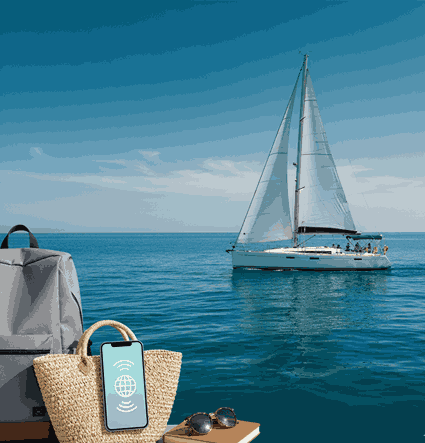Europe transforms into a magical landscape when winter arrives, and 2025-2026 is shaping up to be extraordinary. The Northern Lights are reaching their solar maximum, new festivals are packed into the calendar, and ski resorts are primed for an incredible season.
- 1. Tyrol, Austria: Premier Skiing
- Tip
- 2. Grindelwald, Switzerland: Family-Friendly Slopes
- Tip
- 3. Valais Region, Switzerland: Luxury Peaks
- 4. Bernese Oberland, Switzerland: Winter Hiking Paradise
- Trail Difficulty Levels and Base Access
- 5. Chamonix, France: Mont Blanc
- Chamonix Booking Tips
- 6. Scottish Highlands: Viking Fire Festivals
- Edinburgh Hogmanay: December 29, 2025 – January 1, 2026
- Up Helly Aa in Shetland: January 27, 2026
- Multi-Destination Ferry and Flight Logistics
- 7. Dolomites, Northern Italy: Rose-Tinted Peaks
- Dolomites Planning
- 8. Finnish Lapland: Arctic Adventures
- When to Go to see Northern Lights
- 9. Swedish Lapland, Jukkasjärvi: Hand-Carved Ice Hotel
- How an Ice Hotel Actually Works
- What It’s Like Inside Ice Hotel
- Northern Lights Viewing From Ice Accommodations
- ICEHOTEL Booking Tips
- 10. Northern Norway, Alta: World’s Northernmost Ice Hotel
- The Ice Cathedral and Bar
- When Sorrisniva Igloo Hotel is Open
- Northern Lights Viewing at 70°N
- Combining Ice Hotel With Aurora Hunts
- 11. Central Slovenia, Lake Bled: Budget-Friendly Beauty
- Accessible Routes for Mixed-Fitness Groups
- 12. Transylvania: Remote Wilderness
- Transylvania Planning
- 13. Bavaria, Germany: Violin-Making Heritage
- Budget-Friendly Alternative to Western Europe
- 14. Venice, Italy: A City in Disguise
- When the Venice Carnival Happens in 2026
- Major Events of Venice Carnival
- Planning Your Venice Carnival
- 15. Lyon, France: Lumière Festival
- Tip
- 16. Netherlands: Dutch Ice Sculptures
- Best Time to Visit Ijsbeelden Festival
- 17. Central Lake District, England: Winter Wonderland
- Tips for visiting Lake District in winter
- 2025-2026 Winter Events in Europe
- What to Expect in Europe during winter
- Why Winter in Europe is Worth the Cold
- Read more
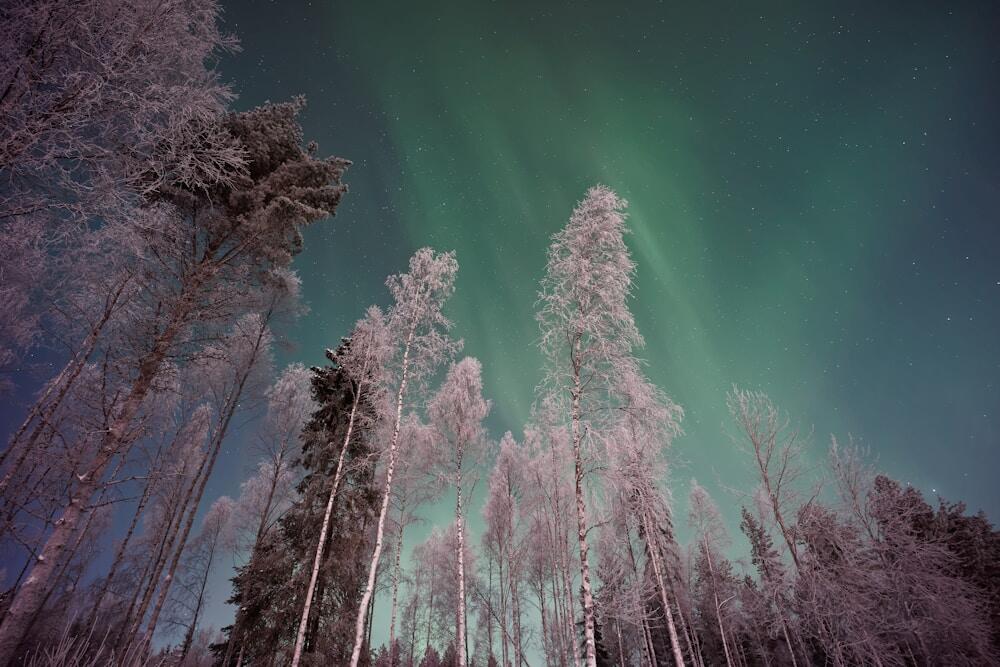
This guide walks you through 17 of Europe’s best winter destinations, complete with insider tips, event dates, and practical booking advice.
1. Tyrol, Austria: Premier Skiing
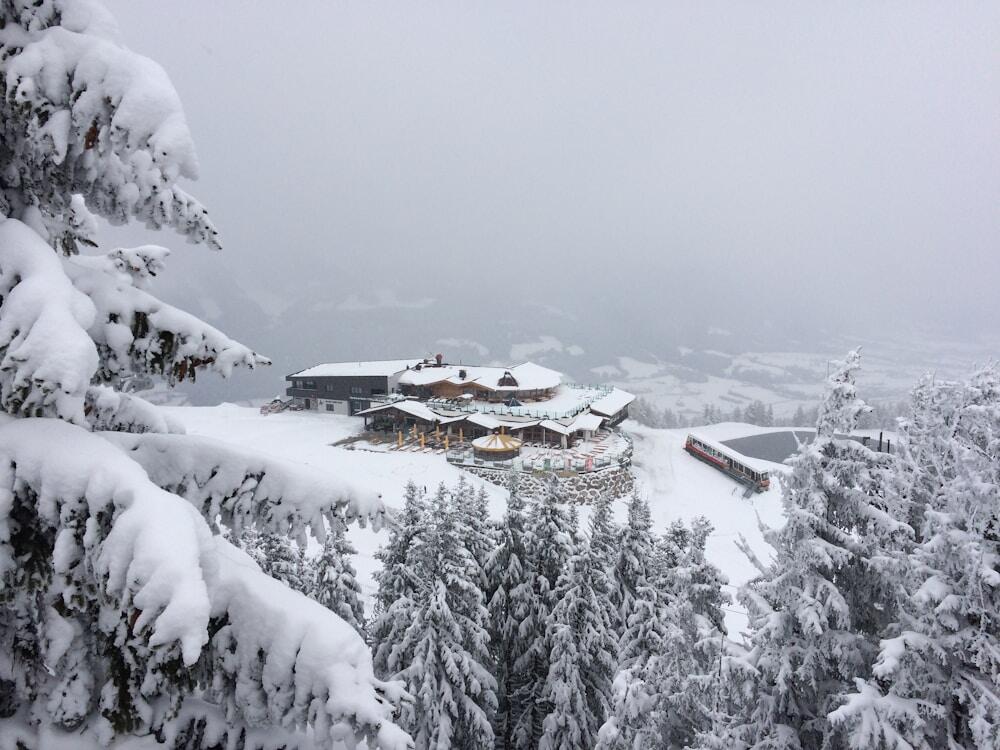
Tyrol is a year-round adventure destination, but winter transforms it into a skier’s paradise mixed with world-class wellness retreats. The region combines challenging terrain, vibrant après-ski, electronic music festivals, and thermal springs in one compact valley.
St. Anton is legendary for its steep, ungroomed terrain and legendary nightlife. The village attracts serious skiers and party enthusiasts who don’t mind tight slopes and intense ski culture. The Arlberg area offers some of Europe’s most demanding off-piste skiing.
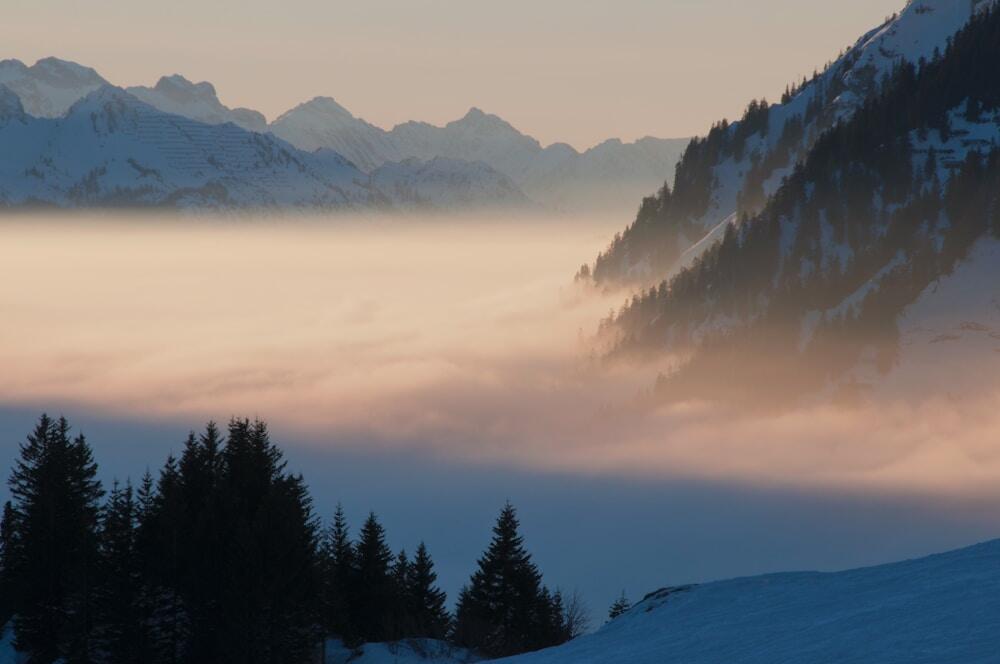
Sölden is famous for its two glaciers: Rettenbach and Tiefenbach, which guarantee snow from September through May. The World Cup slalom and giant slalom events kick off the season here in late October, and lift access goes up to 3,250 meters. You can ski twice as long as in other Austrian resorts.
Tip
Purchase an Arlberg region ski pass for unlimited access to St. Anton, Lech, and Zürs terrain
2. Grindelwald, Switzerland: Family-Friendly Slopes
Grindelwald sits beneath the iconic Eiger, one of the Alps’ most dramatic peaks. The village balances family-friendly terrain with stunning scenery, cable cars, toboggan runs, and easy access to Jungfrau region hiking.
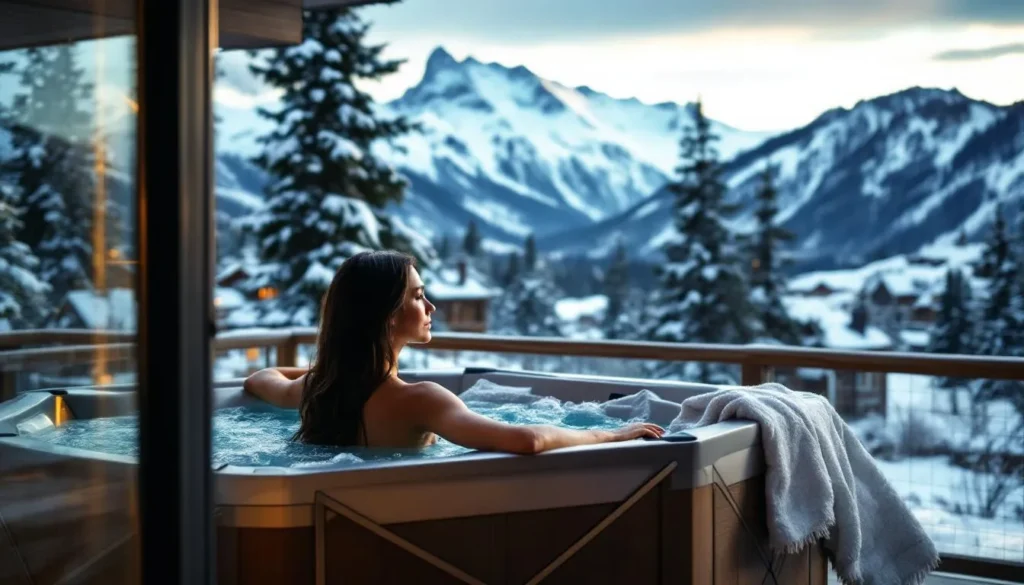
The ski area has a mix of beginner and intermediate terrain, making it ideal for families. Most runs flow downhill naturally, and the village offers après-ski within walking distance. Black runs exist but aren’t the focus here.
The new Eiger Express cable car connects Grindelwald to Eigergletscher, cutting journey time to the Jungfrau region. You can ski across to Wengen and Mürren, creating multi-day ski tours. A single ticket gives you access to interconnected resorts.
Tip
Buy a 3-day Jungfrau Pass to ski Grindelwald, Wengen, and Mürren in 1 trip. Stay in Grindelwald and take trains to neighboring resorts, public transit is reliable.
3. Valais Region, Switzerland: Luxury Peaks
Valais combines high-altitude glacial skiing, world-famous thermal spas, and iconic mountain views. The region is home to both the Matterhorn and the highest ski resort in Switzerland. Off-piste powder and wellness retreats live side by side.
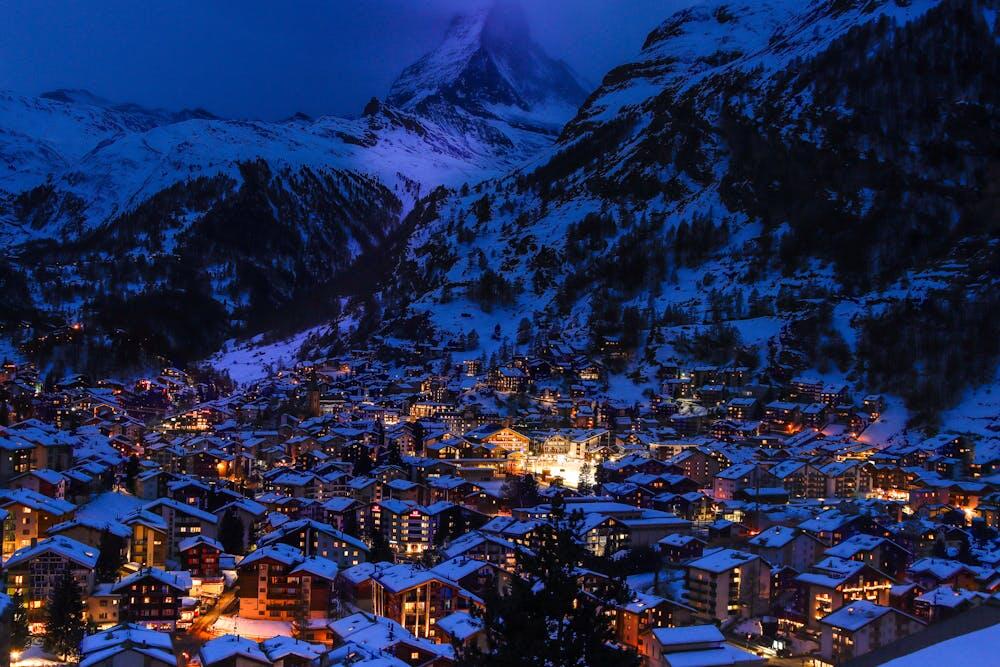
Zermatt is a car-free village at 1,620 meters with spectacular views of the Matterhorn. The Klein Matterhorn cable car reaches 3,899 meters, offering year-round skiing and a 20-kilometer descent. The town feels exclusive, with upscale hotels, fine dining, and a wealthy clientele.
Verbier is the epicenter of off-piste skiing in the Alps. The Four Vallées ski area spans 412 kilometers of terrain across four interconnected valleys. Verbier itself is famous for steep gullies, big mountain freeriding, and a young, energetic après-ski scene.
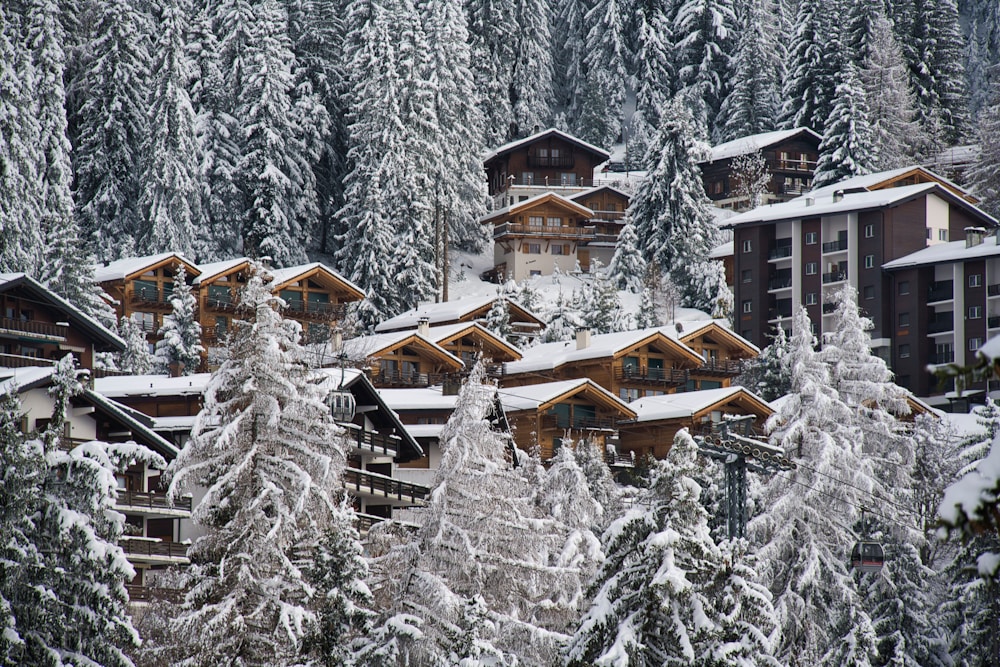
Leukerbad is a spa village with over 65 thermal springs. The water temperature hovers around 51°C (124°F), and outdoor pools offer views of snow-capped peaks. Many visitors combine a day of gentle skiing with afternoons soaking in thermal baths.
Many travelers base themselves in Leukerbad, ski nearby Crans-Montana or Verbier during the day, and return for thermal soaks at sunset. This combination appeals to couples, wellness-focused travelers, and those who want balanced experiences.
4. Bernese Oberland, Switzerland: Winter Hiking Paradise
The Bernese Oberland is perfect for non-skiers, families, and hiking enthusiasts. Dramatic peaks, car-free villages, and well-marked snowshoe trails create a serene winter experience without requiring ski ability.
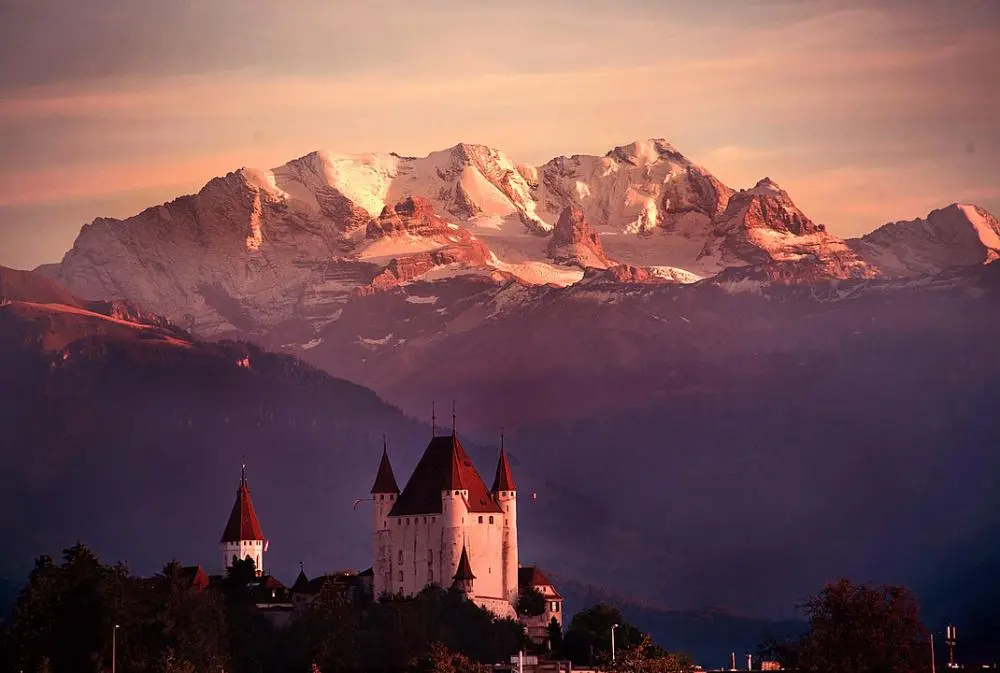
Mürren is reachable only by cable car, making it a quiet, car-free escape. The village sits at 1,638 meters with breathtaking views of the Eiger, Jungfrau, and Matterhorn. Snowshoe trails depart from the village and loop through Alpine meadows.
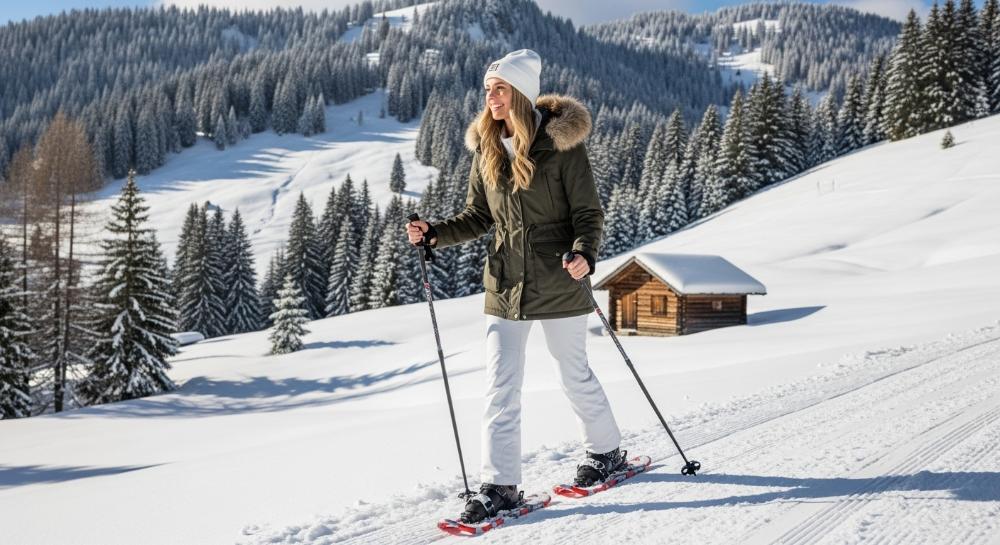
Kandersteg is known as the snowshoeing capital of the Alps. Over 50 kilometers of marked trails radiate from the village, ranging from easy valley walks to challenging high-altitude routes. Oeschinen Lake is frozen in winter and offers stunning photographic opportunities.
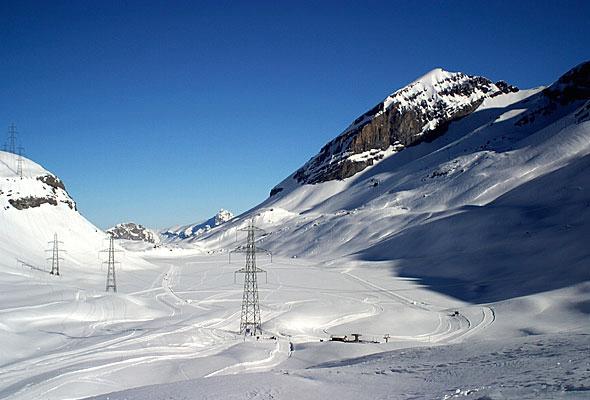
The Gemmi Pass trail climbs to 2,322 meters with 360-degree views of the Alps. Gastern Valley offers a gentler valley walk through limestone formations. Both trails are snowshoed in winter and rarely crowded compared to ski resorts.
Trail Difficulty Levels and Base Access
- Easy routes: Oeschinen Lake loop, valley trails near Kandersteg
- Moderate routes: Gemmi Pass, Gastern Valley, Blausee circuit
- Stay in Interlaken and take trains to Kandersteg (1 hour) or Mürren (2 hours)
- Rent snowshoes in villages; most hikes take 3-5 hours round-trip
5. Chamonix, France: Mont Blanc
Chamonix sits in a dramatic valley beneath Mont Blanc, Europe’s highest peak. The town blends skiing, mountaineering, snowshoeing, and extreme sports. Winter transforms the valley into a playground for adventurous travelers.
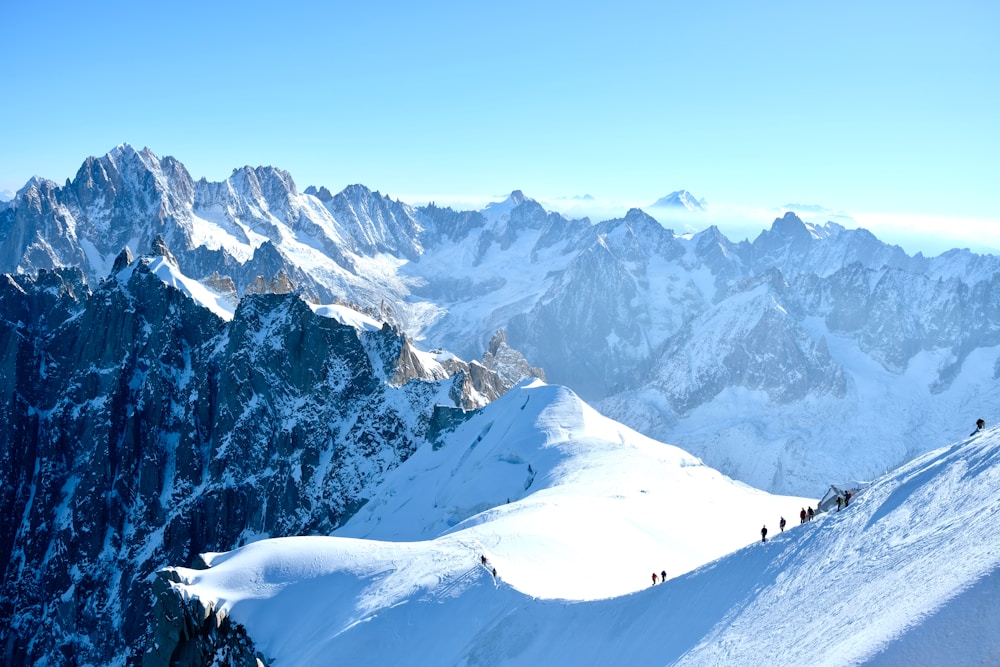
Snowshoe trails loop around the valley, offering constant views of Mont Blanc. The Grand Balcon Nord trail is a favorite: it’s high altitude but relatively accessible, with restaurants at intermediate points. Mer de Glace glacier (Europe’s second-largest) is also visitable by snowshoe.
Argentière Glacier sits at 2,560 meters and offers spectacular high-altitude views. Grand Balcon Nord is a multi-hour walk along a narrow trail that feels like a balcony above the valley. Both require good fitness and proper winter hiking boots.

Chamonix has rifugios and mountain restaurants at mid-elevations. Afternoon descents from high trails often conclude at village bars for mulled wine and fondue. The town’s après-ski is more relaxed than Austrian resorts, focused on mountaineering culture.
Chamonix Booking Tips
- Book guided tours 1-2 weeks in advance during peak season
- Bring traction devices (microspikes) for icy trail sections
- Check avalanche forecasts daily; some routes close seasonally
6. Scottish Highlands: Viking Fire Festivals
The Scottish Highlands offer two of Europe’s most unique winter celebrations: Edinburgh Hogmanay (New Year’s Eve) and Up Helly Aa (a Viking fire festival). These events blend history, community, and unforgettable spectacle.
Edinburgh Hogmanay: December 29, 2025 – January 1, 2026
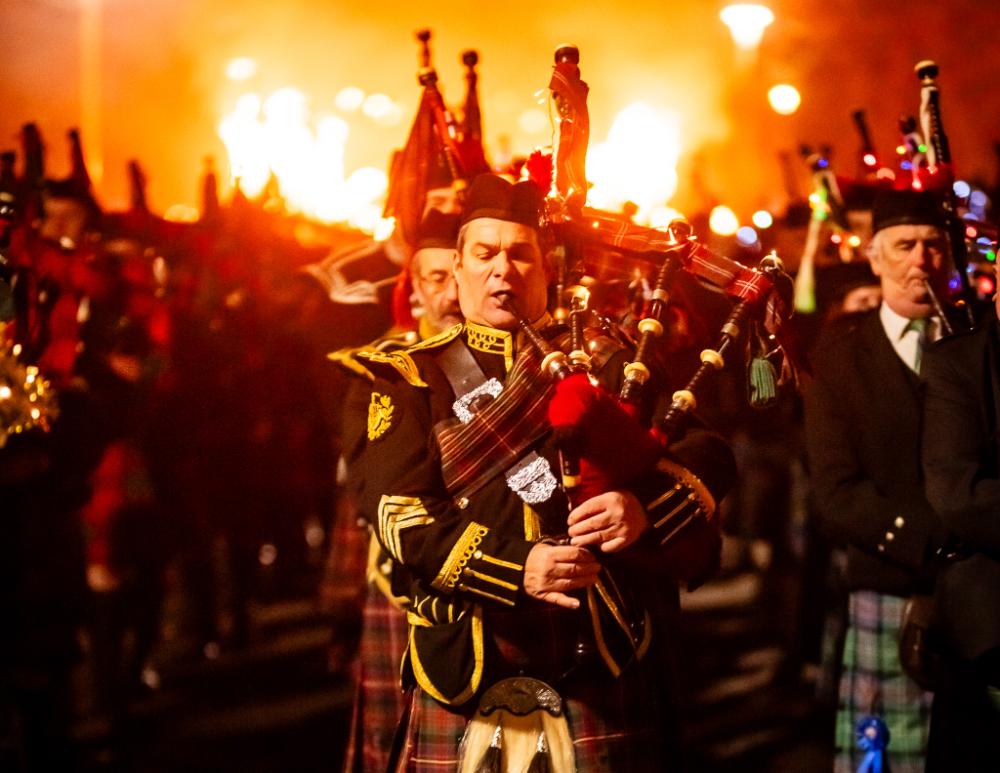
Edinburgh Hogmanay is one of the world’s largest New Year celebrations. The festival includes the Torchlight Procession (December 30), street parties, concerts, and a massive fireworks display over the castle at midnight. Tickets for ticketed events sell out by November.
Up Helly Aa in Shetland: January 27, 2026
Up Helly Aa is a Viking fire festival where locals carry flaming torches through the streets of Lerwick (Shetland Islands), then burn a replica Viking longship. The festival honors Norse heritage and is followed by community parties. It’s one of Europe’s most dramatic winter events.
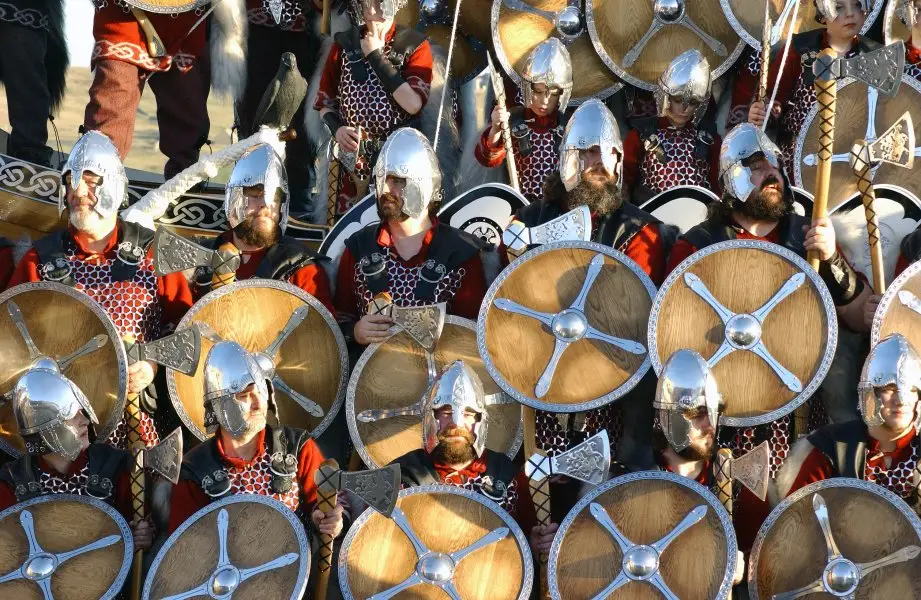
Both events welcome visitors. Edinburgh’s street parties are ticketed; Up Helly Aa’s torchlit parade and ship burning are free. Expect crowds, bundled-up spectators, and genuine community spirit—not commercialized tourism.
Multi-Destination Ferry and Flight Logistics
- Shetland (Up Helly Aa): Fly from Edinburgh to Lerwick (1 hour flight) or take a ferry (13 hours)
- Book ferries and flights for Shetland as soon as dates are announced
- Wear waterproof clothing; both festivals involve outdoor celebrations in cold, damp weather
7. Dolomites, Northern Italy: Rose-Tinted Peaks
The Dolomites are UNESCO-listed mountains famous for their rose-tinted slopes (alpenglow at sunrise and sunset). The region combines accessible winter hiking, charming mountain villages, and authentic Italian cuisine in rifugio huts.
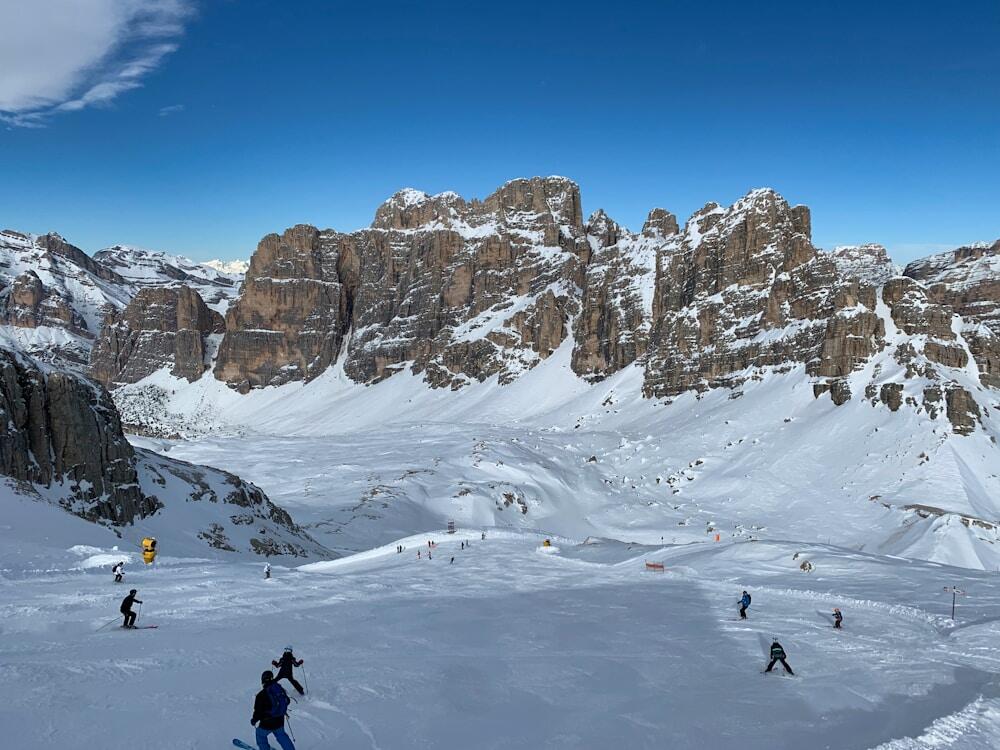
Cortina d’Ampezzo will co-host the 2026 Winter Olympics (with Milan). The town is a sophisticated mountain resort with excellent snowshoeing, rifugio dining, and luxury accommodation. Winter brings milder temperatures than Austrian or Swiss Alps.
Cinque Torri (Five Towers) offers stunning via ferrata routes and winter hiking. The Three Peaks (Tre Cime di Lavaredo) circuit is a famous multi-day hike that’s snowshoed in winter. Both routes showcase dramatic limestone formations and expansive Alpine views.

Rifugios are mountain huts that serve simple Italian meals and drinks. Many visitors hike to a rifugio for lunch, enjoy wine and local cheese, then toboggan or sled back downhill. It’s a uniquely Italian Alpine experience.

The Dolomites have a distinct Ladin culture (Tyrolean heritage mixed with Italian influence). Local cuisine features speck (cured ham), casunziei (stuffed pasta), apple strudel, and wines from nearby valleys. Villages retain authentic character without tourist commercialization.
Dolomites Planning
- Base yourself in Cortina d’Ampezzo; it’s more sophisticated than other Dolomite towns
- Expect more tourists in 2026 due to Olympics; consider visiting January-February for fewer crowds
- Book rifugio lunch reservations online if visiting peak season
8. Finnish Lapland: Arctic Adventures
Finnish Lapland is the Arctic north. The 2025-2026 solar maximum means Northern Lights visibility is at its peak. Glass igloos, dog sledding, reindeer safaris, and visits to Santa’s official hometown make this a bucket-list winter destination.
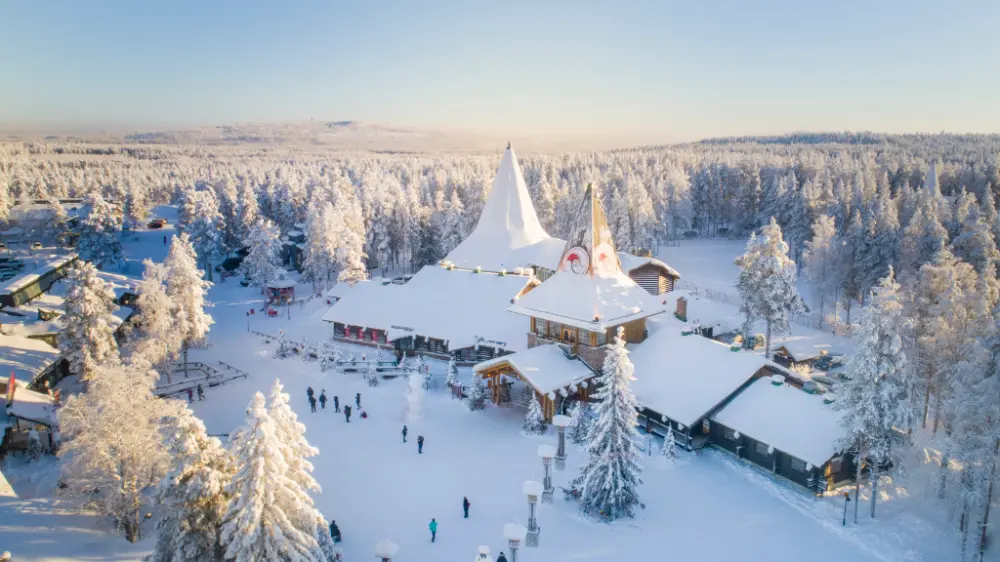
Rovaniemi is officially home to Santa Claus (at Santa Claus Village). Visitors meet Santa, tour his office, and slide down ice slides. The village sits on the Arctic Circle, making it feel like the top of the world. Winter temperatures drop to -20°C (-4°F).

The solar cycle peaks in 2025-2026, meaning increased geomagnetic activity and frequent Northern Lights. Clear-sky nights in December-February offer 70-90% visibility rates in Finnish Lapland. Aurora forecasts update hourly; many lodges have wake-up calls for aurora sightings.
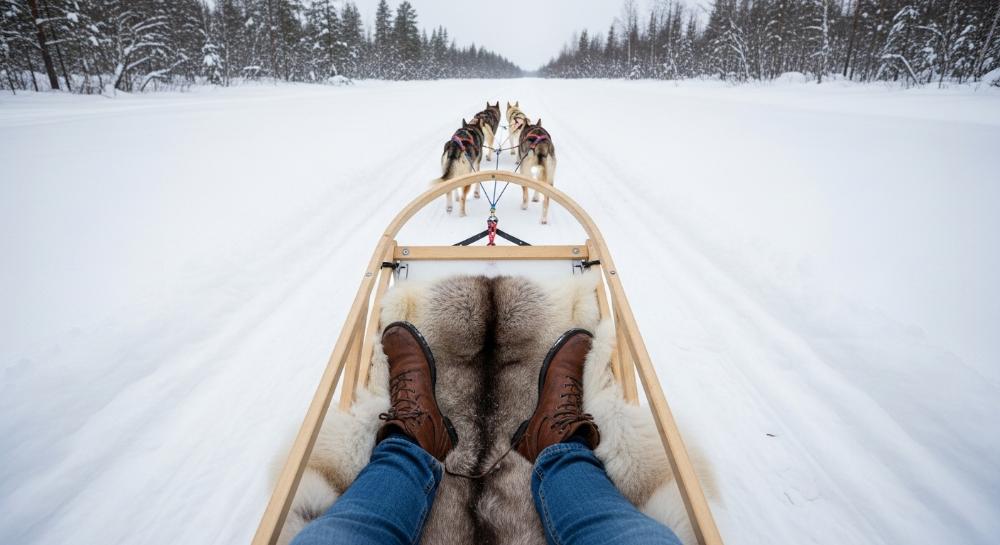
Husky dog sledding is the iconic Lapland experience. Visitors team with 4-6 dogs and mush through snowy forests for 1-3 hour outings. Snowmobile tours cover vast distances quickly. Reindeer sleigh rides move slower but feel more intimate with animals.
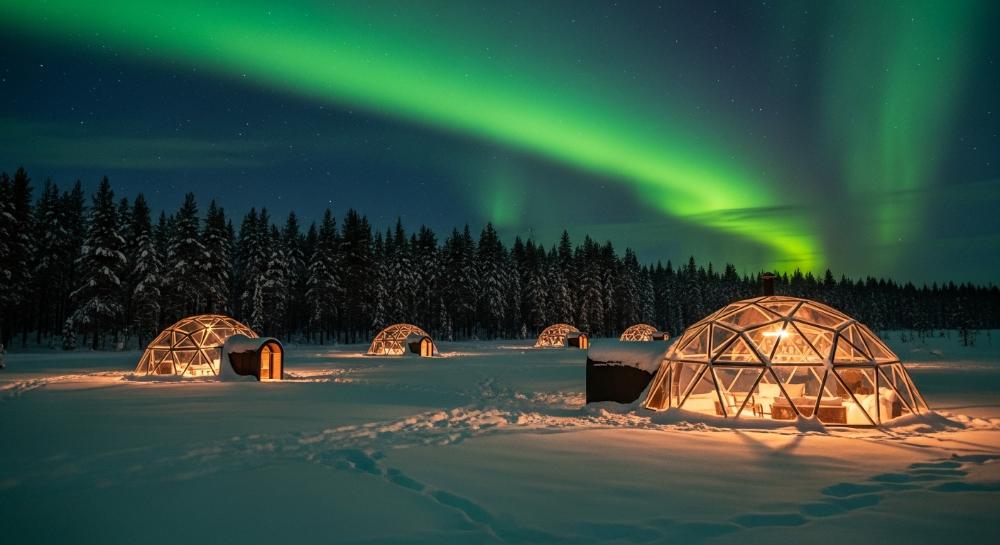
Saariselkä is about 250 kilometers east of Rovaniemi. The Kakslauttanen Arctic Resort features glass igloo rooms with heated floors and see-through roofs. You watch Northern Lights from bed. Rooms book out 6-12 months in advance.
Glass igloo resorts use aurora alarm systems that detect bright lights and wake guests. You can see the Northern Lights without leaving your bed. The experience is surreal: bright green curtains of light dancing above snowy silence.
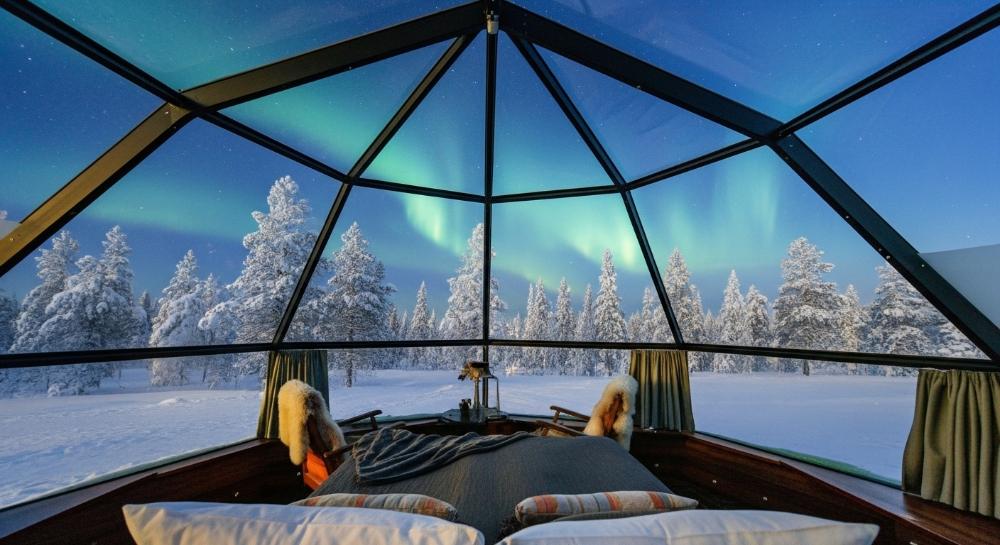
Many glass igloo rooms include private saunas. After outdoor activities, you sauna and then step outside to see the aurora in the cold. Some resorts offer hot tubs with glass walls for bathing under the lights.
When to Go to see Northern Lights
- Best aurora viewing: December-January (continuous darkness, high solar activity)
- Book glass igloos 8-12 months in advance for premium dates
- Peak pricing: December 20-January 2 (expect 2x normal rates)
- Budget alternative: Stay in Rovaniemi base accommodations and day-trip to glass igloos
- Pack thermal layers, insulated boots, and face protection; -20°C is serious cold
9. Swedish Lapland, Jukkasjärvi: Hand-Carved Ice Hotel
Swedish Lapland’s ICEHOTEL in Jukkasjärvi is made entirely from ice and snow from the Torne River and gets rebuilt from scratch every winter. International artists come back each year to design and carve new rooms.
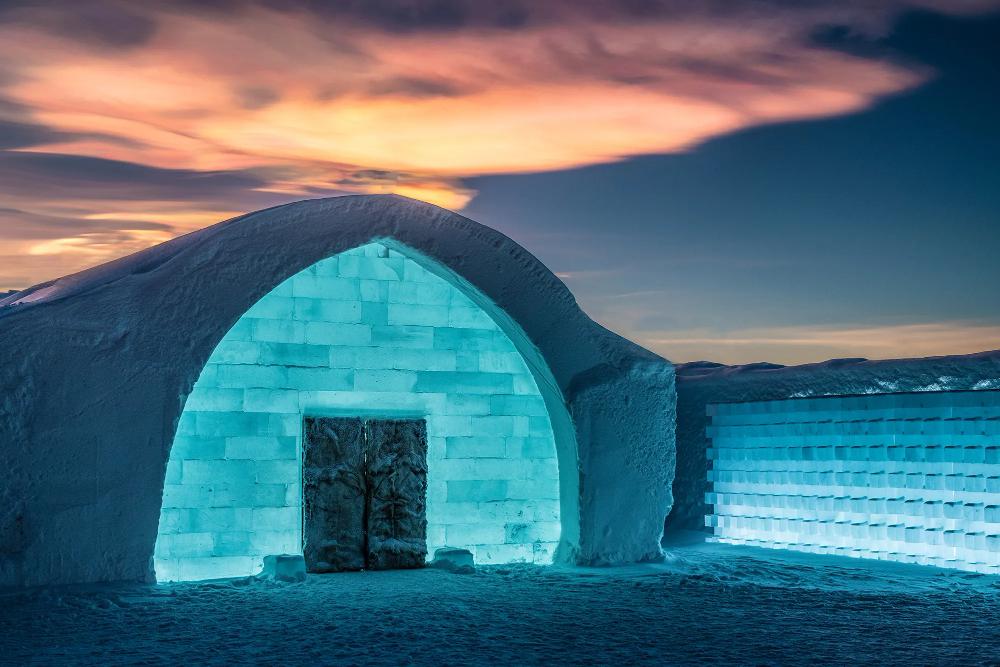
How an Ice Hotel Actually Works
The hotel opened in 1989 and has been rebuilt every winter since. It uses about 4,000 tons of ice and snow from the Torne River. Everything: walls, beds, furniture, the bar, is carved from ice. By spring it melts, and the cycle starts over the next winter.
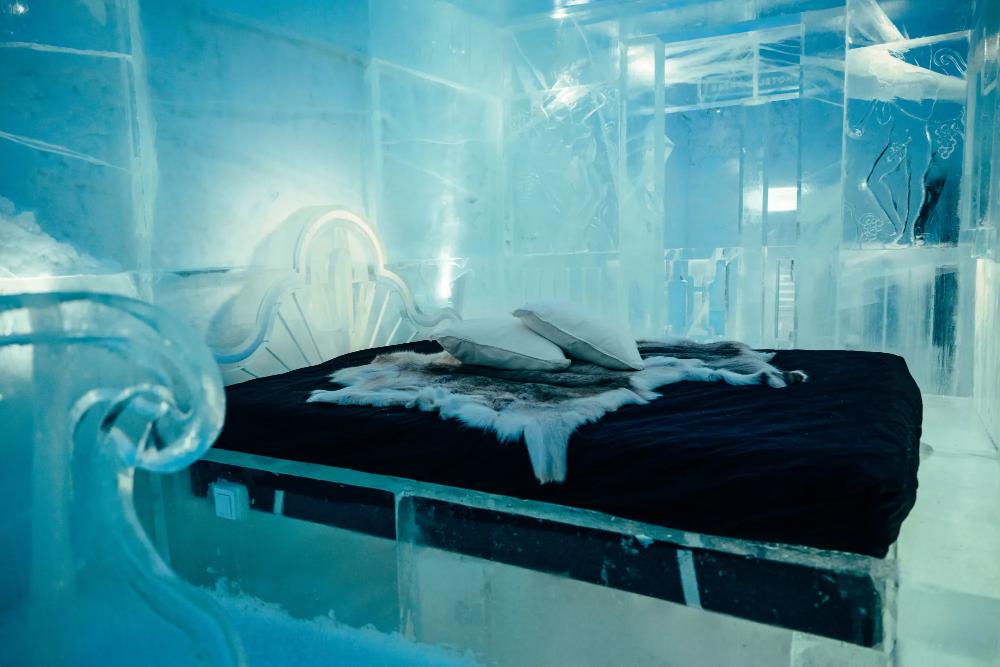
What It’s Like Inside Ice Hotel
Rooms stay at around -5°C (23°F). Beds are ice platforms with reindeer hides on top and thermal sleeping bags that keep you warm down to -20°C. Different artists design different rooms each year, so they look pretty different from each other. There’s also an ice chapel used for ceremonies.
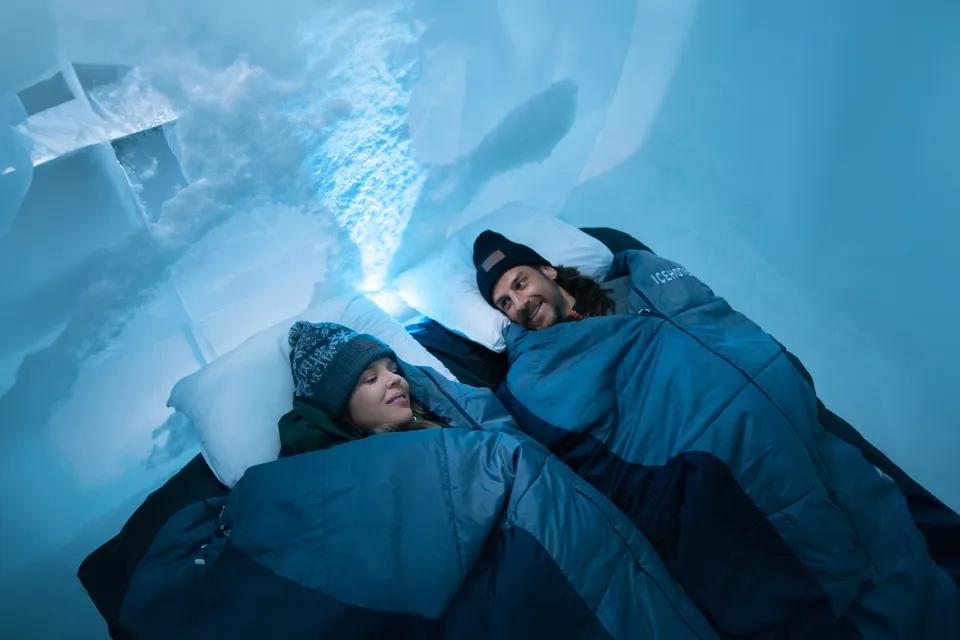
Artists show up in November and start carving. Visitors can actually watch them work and see how they turn big blocks of ice into rooms and sculptures. The hotel opens in December and runs until April when it melts away.
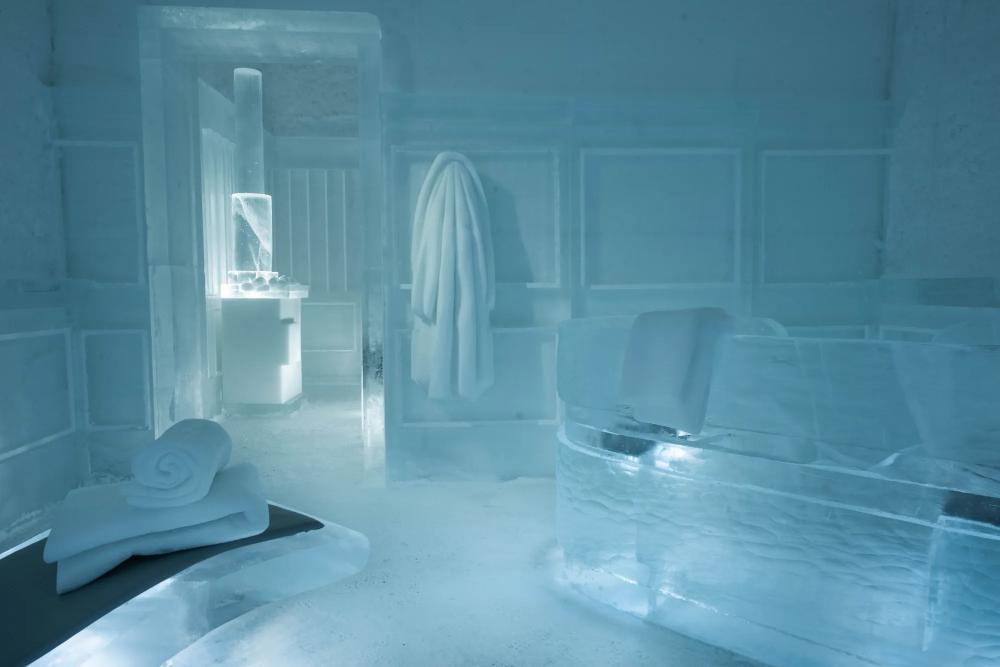
Northern Lights Viewing From Ice Accommodations
It’s located at 66.4°N, which is far enough north that you have decent chances of seeing the Northern Lights in winter. Some rooms have windows positioned to watch for them.
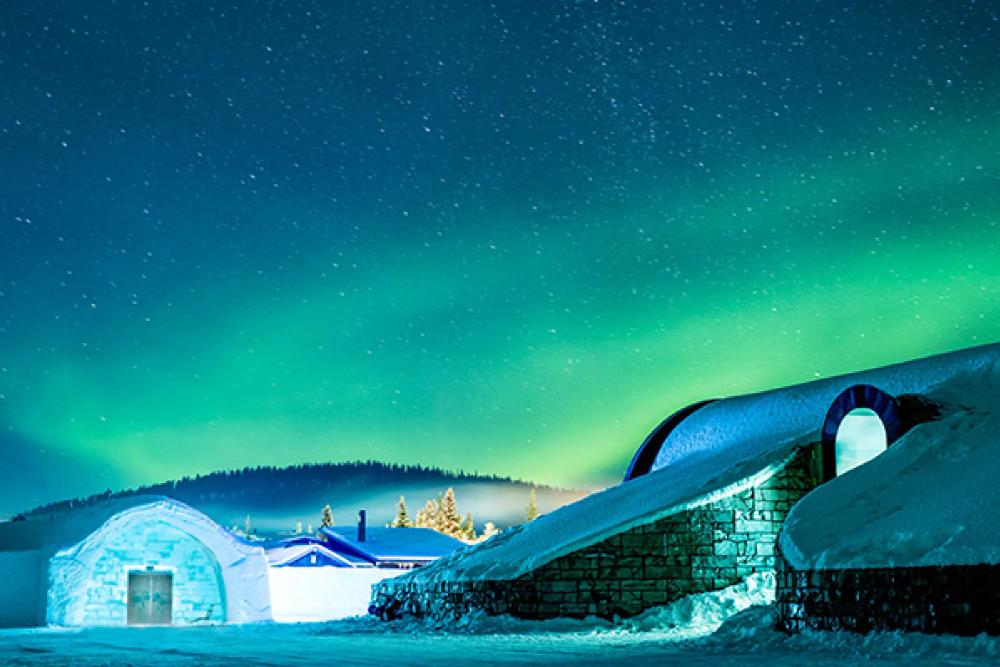
ICEHOTEL Booking Tips
- Book 6-8 months in advance; artist suites book out fastest
- Standard ice rooms are cheaper than artist suites but equally unique
- Plan for 2-3 nights; one night feels rushed given travel time
- Fly to Kiruna airport (Swedish Lapland hub), then drive 1 hour to Jukkasjärvi
10. Northern Norway, Alta: World’s Northernmost Ice Hotel
Alta is in the Norwegian Arctic, about 70 kilometers north of the city itself. The Sorrisniva Igloo Hotel sits here at 70°N latitude, making it the northernmost ice hotel in the world. It’s an extremely remote location with strong potential for seeing the Northern Lights.
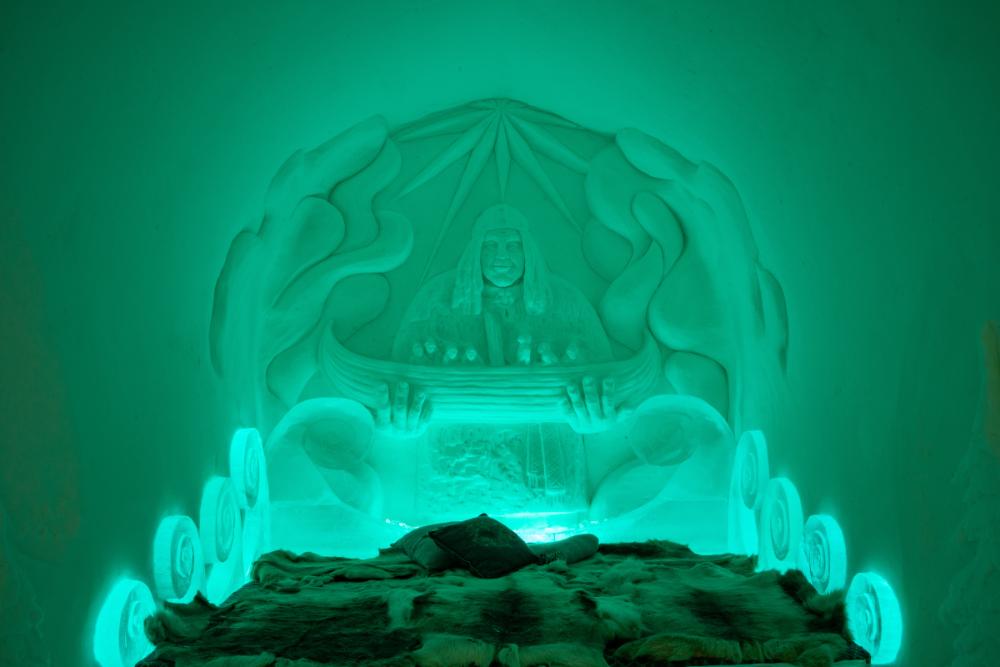
Rooms are built fresh from snow and ice each season. The hotel has a more rustic feel compared to the Swedish ICEHOTEL, it’s less polished but offers a deeper sense of being in the Arctic. If you need a break from the cold, heated rooms are available too.
The Ice Cathedral and Bar
The hotel has an Ice Cathedral used for ceremonies and a bar called King Valemon’s. The bar features ice sculptures and serves drinks inspired by Samí culture. It feels genuinely Arctic rather than designed for tourists.
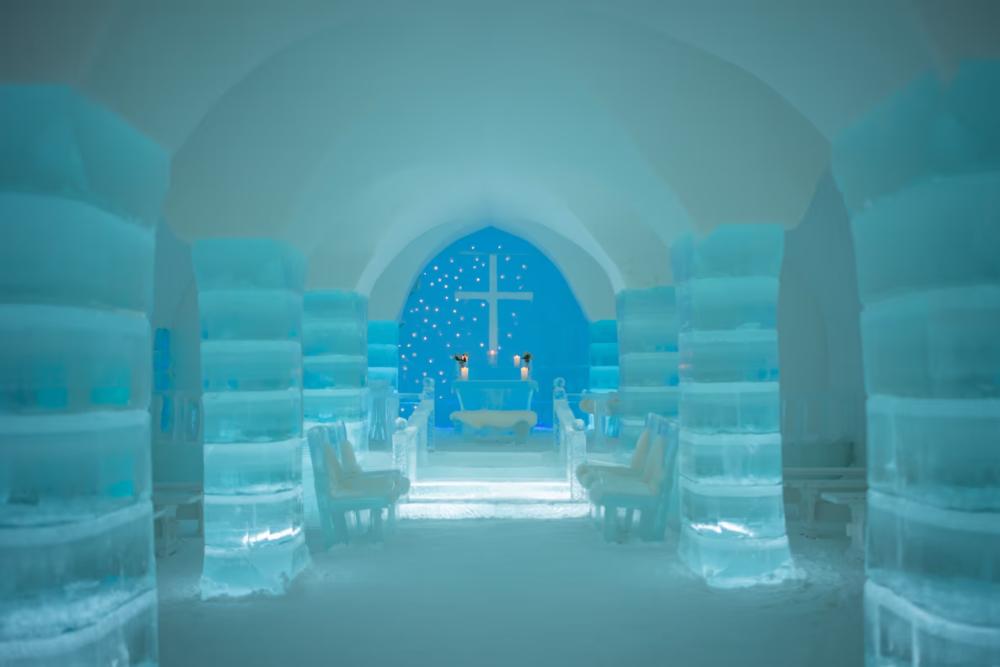
When Sorrisniva Igloo Hotel is Open
Sorrisniva operates from December 20 through April 1. The season starts right after the winter solstice when Arctic darkness peaks and aurora activity is strong. It closes before the midnight sun arrives in spring.
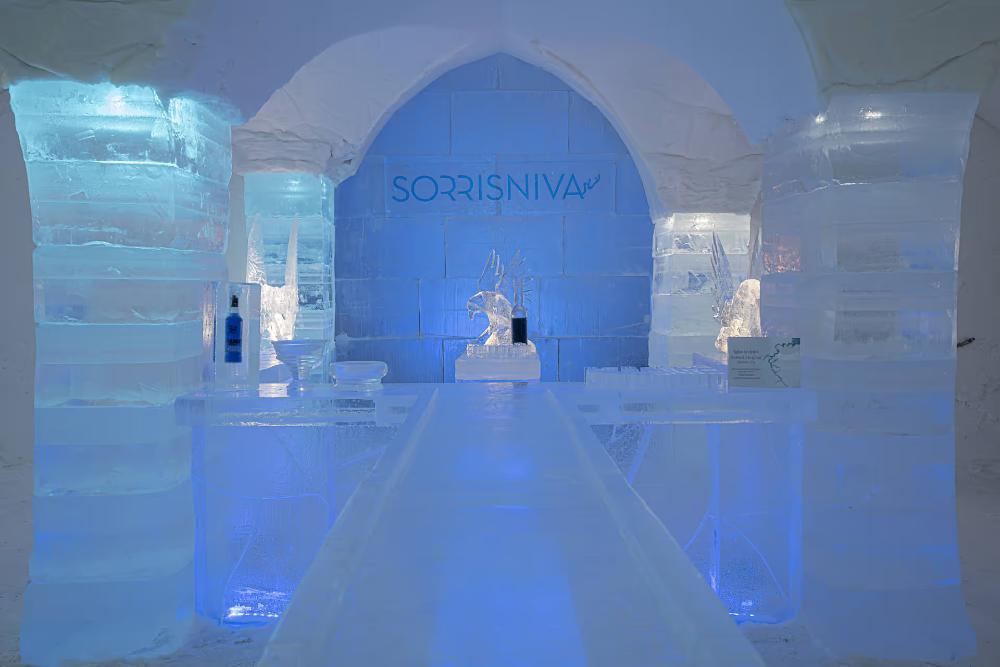
Northern Lights Viewing at 70°N
Alta is known as the city of the Northern Lights because of how often they appear here. Sorrisniva is located far enough outside the city that there’s minimal light pollution, which improves your chances of seeing the aurora. The location is one of Europe’s best spots for Northern Lights viewing during winter months.
Combining Ice Hotel With Aurora Hunts
- Stay 2-3 nights; first night for aurora acclimatization, remaining nights for hunts
- Book aurora tours through the hotel; guides have local expertise
- Expect temperatures to -25°C (-13°F); bring extreme-weather clothing
- Fly to Tromsø or Bodø, then drive to Alta (4-5 hours)
11. Central Slovenia, Lake Bled: Budget-Friendly Beauty
Lake Bled is Slovenia’s crown jewel. Winter transforms the glacial lake into a frozen landscape with misty forests. It’s significantly cheaper than Austria or Switzerland while offering equally stunning scenery and less crowding.
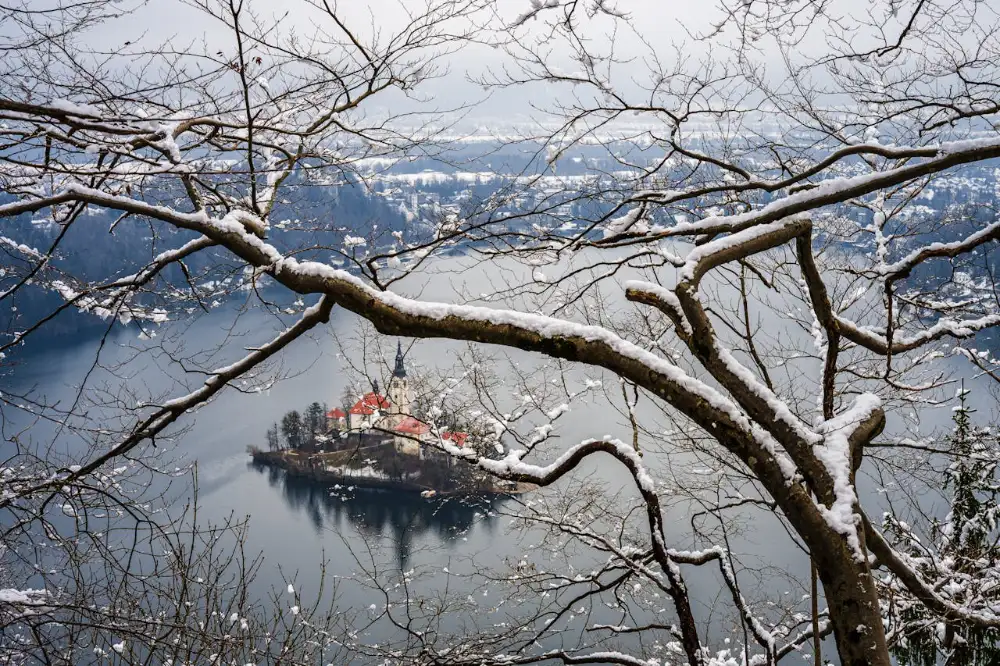
Lake Bled itself freezes partially in winter. A circumference walk (6 kilometers) offers lake and mountain views. Triglav National Park, which surrounds Bled, has 30+ winter hiking trails ranging from easy to expert.
Bohinj Valley, 20 kilometers south of Bled, offers snowshoeing through beech forests and along frozen Bohinj Lake. The valley has karst limestone formations creating dramatic canyon walls. It feels pristine and untouched.
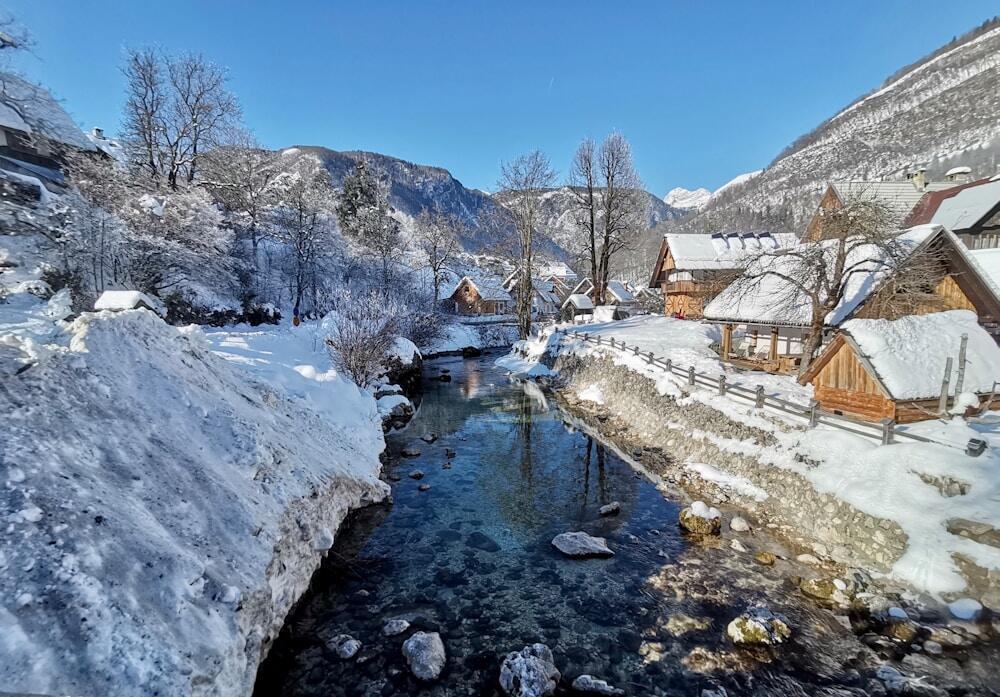
Slovenia blends Alpine and Mediterranean characteristics. Villages have stone houses with sloped roofs. Lodges serve local cuisine: trout, mushroom soups, and apple strudel. The vibe is quieter and more authentic than overtouristed Alpine towns.
Accessible Routes for Mixed-Fitness Groups
- Easy: Bled Lake circumference, lower Bohinj Valley trails
- Moderate: Ojstrica Viewpoint above Bled, Debeli Vrh hiking trail
- Prices are 30-50% cheaper than Switzerland or Austria
- Stay in Bled town; it has more services than Bohinj Valley
12. Transylvania: Remote Wilderness
Transylvania’s Carpathian Mountains are Europe’s last true wilderness. Winter brings snow-covered ancient forests, remote mountain villages, and opportunities to track wolves and bears—experiences impossible elsewhere in Europe.
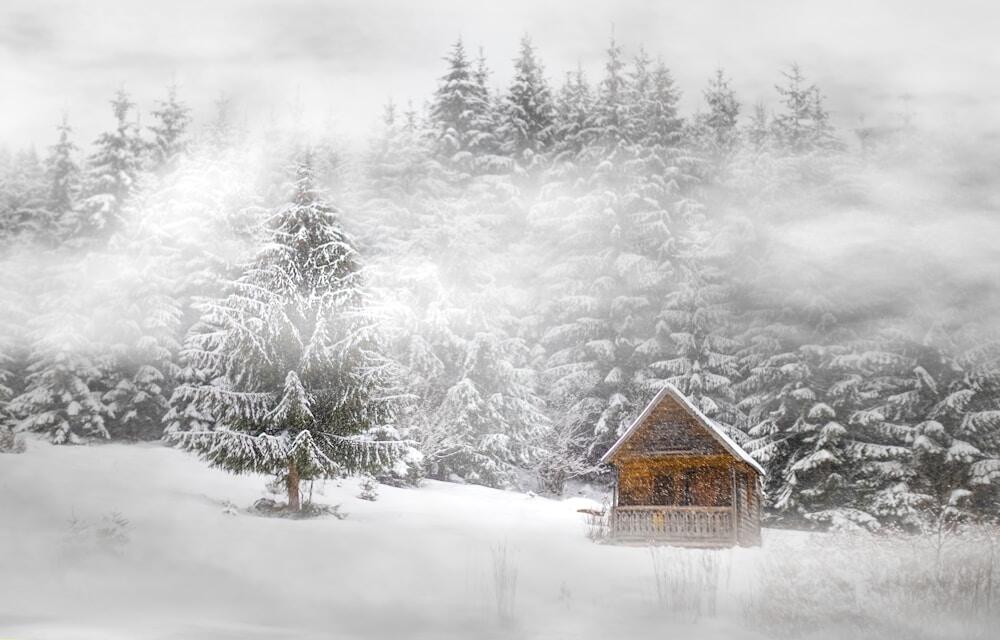
Vast stretches of primeval forest remain unspoiled. Winter snowshoeing feels like stepping back centuries. Trails are rarely marked or crowded. The silence and isolation are profound, no sounds except wind and occasional wildlife.Wolf and Bear Tracking in Authentic Mountain Villages
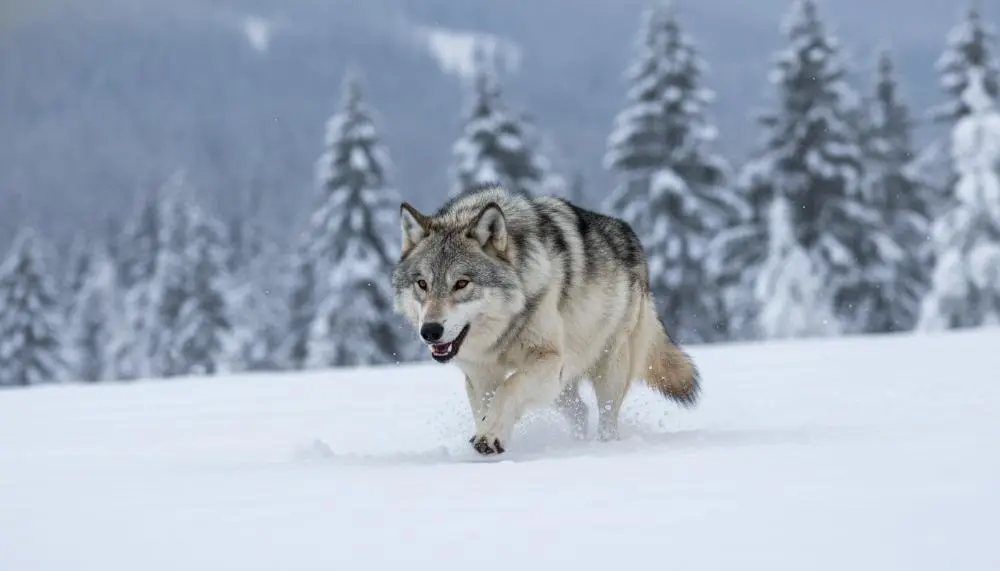
Transylvania hosts Europe’s largest wolf and bear populations. Guides lead tracking expeditions following animal trails and signs. Sightings aren’t guaranteed, but the wilderness experience is authentic. Villages remain traditional, with few tourists, and genuine hospitality.
Scărisoara Cave holds Romania’s largest underground glacier (50 meters thick). Winter access involves hiking to the cave entrance and descending into subterranean ice formations. Other caves offer summer access; winter adds the surreal element of glacial ice.
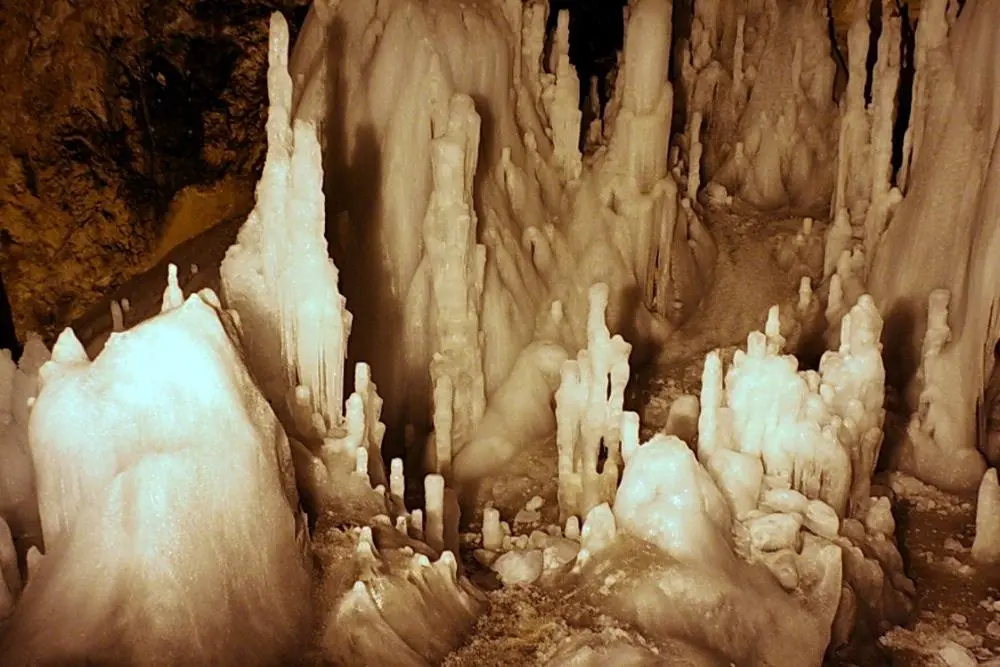
In deep winter, horse-drawn sleighs replace hiking to remote rifugios. You travel through silent forests by sleigh, arriving at candlelit huts for traditional meals. It’s a time-travel experience to pre-modern mountain life.
Transylvania Planning
- Book wolf/bear tracking guides through local tourism offices or lodges
- Base yourself in villages like Zarnesti or Piatra Craiului
- Travel is slower and less organized than Western European Alps, expect adventure
- This is one of Europe’s most affordable winter destinations
13. Bavaria, Germany: Violin-Making Heritage
Bavaria’s Garmisch-Partenkirchen region offers Germany’s highest peaks, classic Alpine towns, and the unique heritage of violin craftsmanship. Winter skiing blends with cultural exploration.
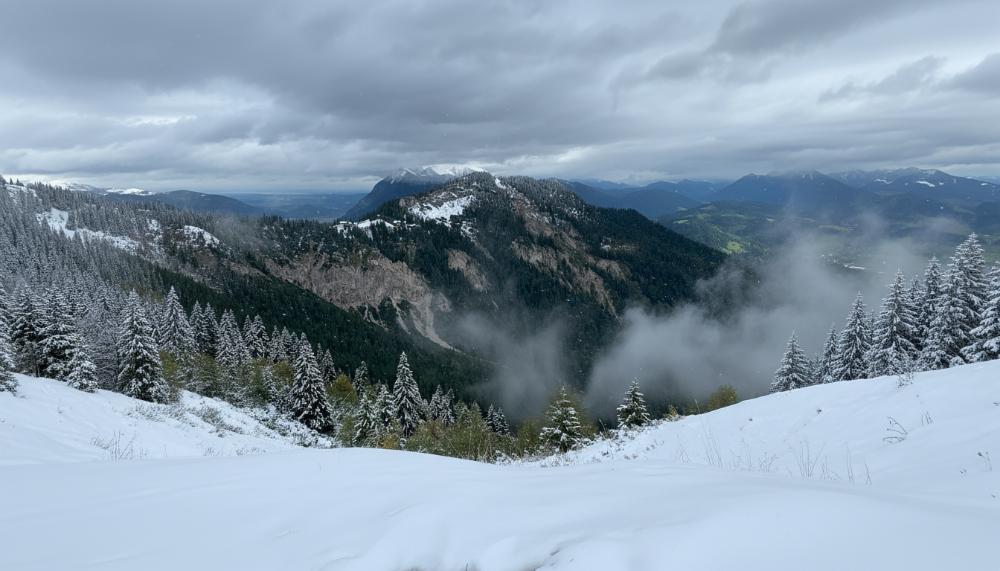
Garmisch-Partenkirchen is Germany’s winter sports capital. The town hosted the 1936 Winter Olympics and remains a major skiing and climbing destination. Terrain ranges from beginner to advanced across three interconnected mountains.
Zugspitze (2,962 meters) is Germany’s highest peak. A new cable car with glass cabins rises from the base, offering 360-degree views. On clear days, you see Bavaria, Tyrol, and the Alps stretching to Switzerland and France.
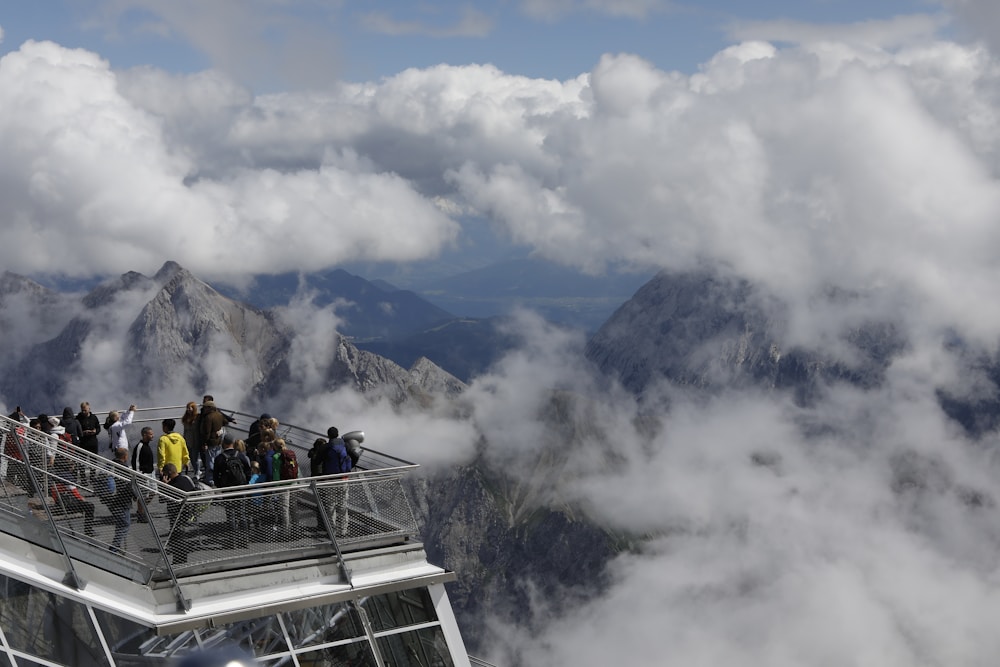
Mittenwald, 15 kilometers south, is a beautifully preserved medieval town famous for violin craftsmanship. Lüftlmalerei (frescoes on house facades) cover buildings in geometric patterns. The town feels frozen in time, quiet and atmospheric in winter.
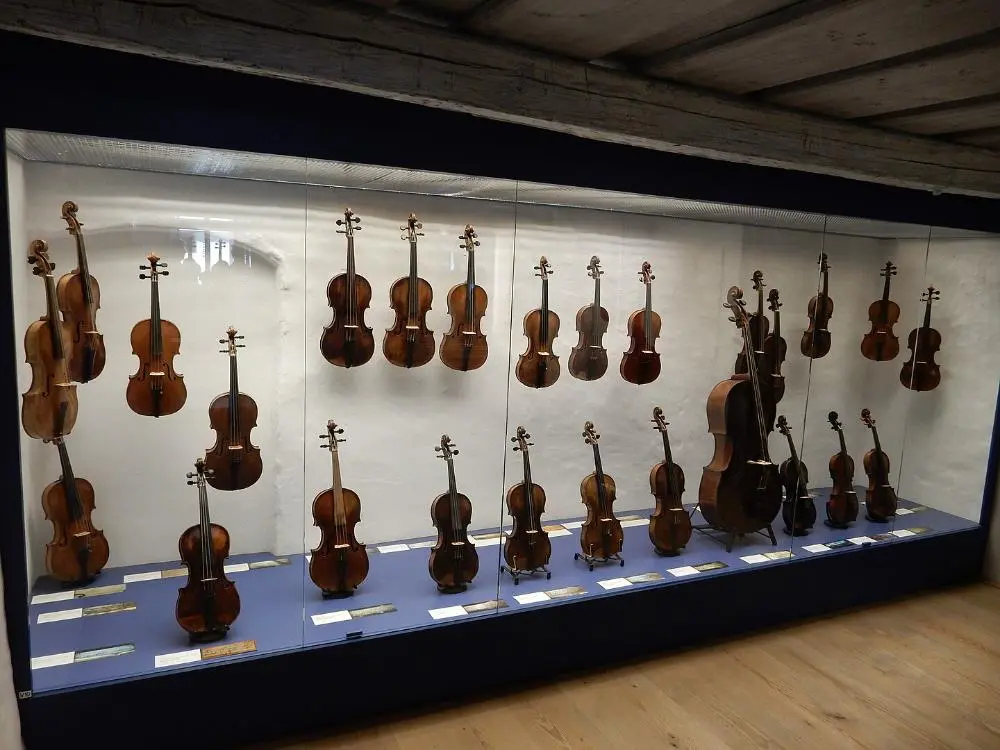
Mittenwald’s Geigenbaumuseum (Violin-Making Museum) displays 300+ handcrafted violins and explains construction techniques. The Karwendelbahn cable car rises above town, offering hiking and views. The combination of culture and nature is unique.
Budget-Friendly Alternative to Western Europe
- Bavaria prices are 20-30% lower than Switzerland or Austria
- Accommodation and dining are significantly cheaper than Tyrol
- Train access: Munich is a major hub; drive or train to Garmisch-Partenkirchen (2 hours)
- Day-trip to Mittenwald from Garmisch-Partenkirchen (15 minutes by car)
14. Venice, Italy: A City in Disguise
Venice transforms during Carnival season. The entire city becomes a masked ball suspended above the canals. Elaborate costumes, centuries-old traditions, and the surreal beauty of Venice create an unforgettable festival atmosphere that feels like stepping into another era.
When the Venice Carnival Happens in 2026
Carnival runs from January 31 through February 17, 2026, but the main events and heaviest crowds hit between February 7-17. The official theme for 2026 is “Olympus: At the Origins of the Game,” celebrating the Olympic spirit since Italy is hosting the Winter Olympics that year.
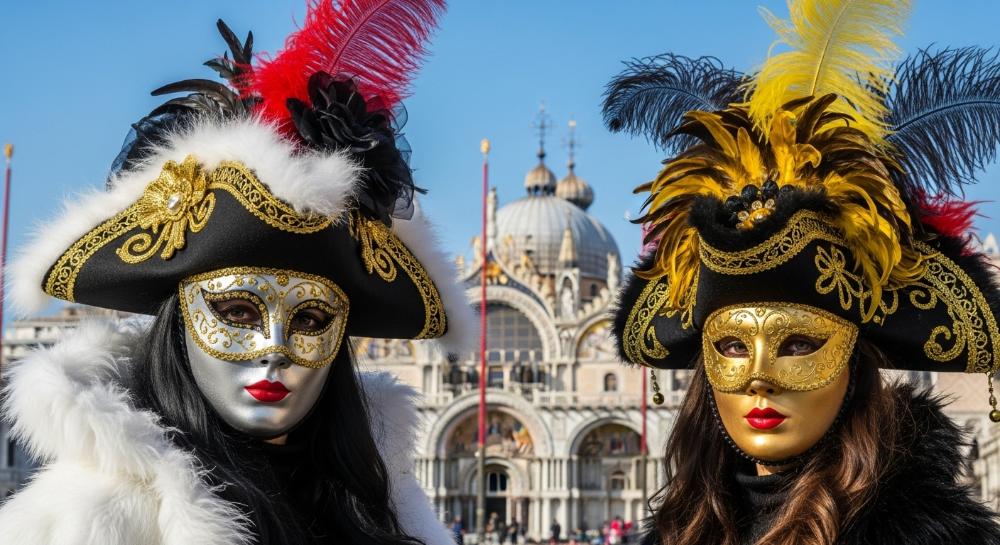
Venetians and visitors wear elaborate masks: volte, larva, and bauta are the traditional styles, paired with 18th-century-inspired costumes. You’ll see people everywhere in full period dress walking the ancient streets. Mask-making shops throughout the city demonstrate techniques that have been used for centuries, and you can watch artisans work or buy directly from them.
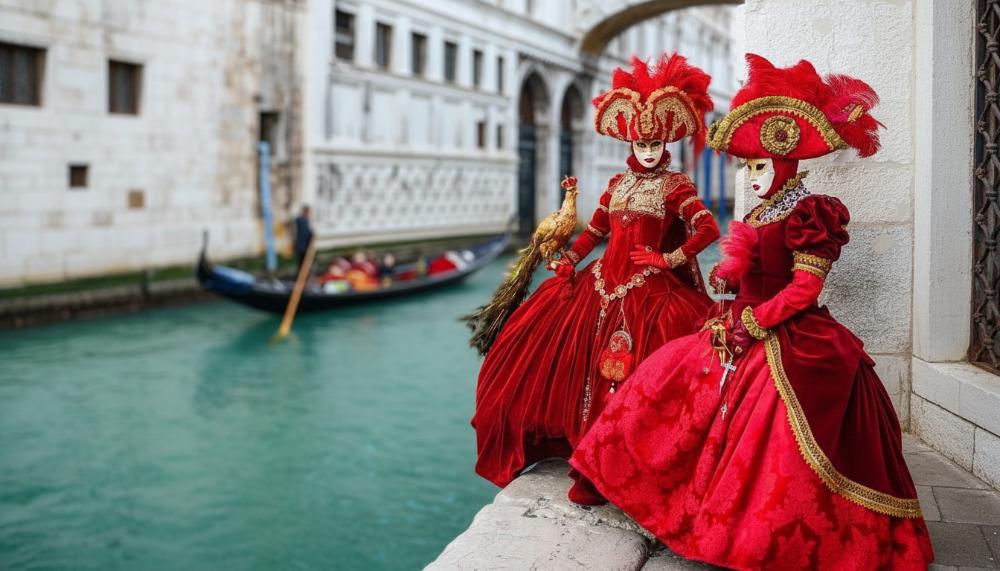
San Marco Basilica serves as the backdrop for major festivities, and the Grand Canal fills with masked revelers in gondolas. The Opening Ceremony features the Flight of the Angel, where a performer descends on a cable from the bell tower. It’s one of the most anticipated events of the season. Streets turn into an open-air theater with street performers posing in character for photos (these are tip-based).
Major Events of Venice Carnival
The Carnival calendar is packed with themed balls, parades, and ceremonies throughout the 2-week period. Some events are exclusive ticketed affairs, while others are free street celebrations. Here’s what to expect during your visit.
- Ball of Dreams (February 7) – An elaborate gala ball featuring masked guests in formal period costumes. This is one of the most popular ticketed events, so book in advance if you want to attend.
- Doge’s Ball (February 14) – An exclusive and prestigious masquerade ball on Valentine’s Day. This is typically one of the most expensive events but offers an authentic Venetian aristocratic experience.
- Festa delle Marie – A famous daytime procession that recreates a medieval tradition where young women from Venice’s leading families were celebrated. It’s a free event and one of the most photogenic moments of the festival.
- Flight of the Angel – The opening ceremony where a performer in elaborate costume descends from the bell tower on a cable over St. Mark’s Square. This is the official kickoff of Carnival and draws massive crowds.
- Daily Costume Parades – Throughout the festival, especially in the evenings, St. Mark’s Square and surrounding streets fill with spontaneous parades of masked performers and costumed revelers. These are free and capture the chaotic, festive energy of Carnival.
Planning Your Venice Carnival
Book hotels 3-4 months in advance: prices triple during Carnival, so early booking is essential. If hotel prices are brutal, consider staying in nearby Padua or Verona and taking the train into Venice. Buy your masks and costumes online before you arrive; Venice shop prices are heavily inflated for tourists.
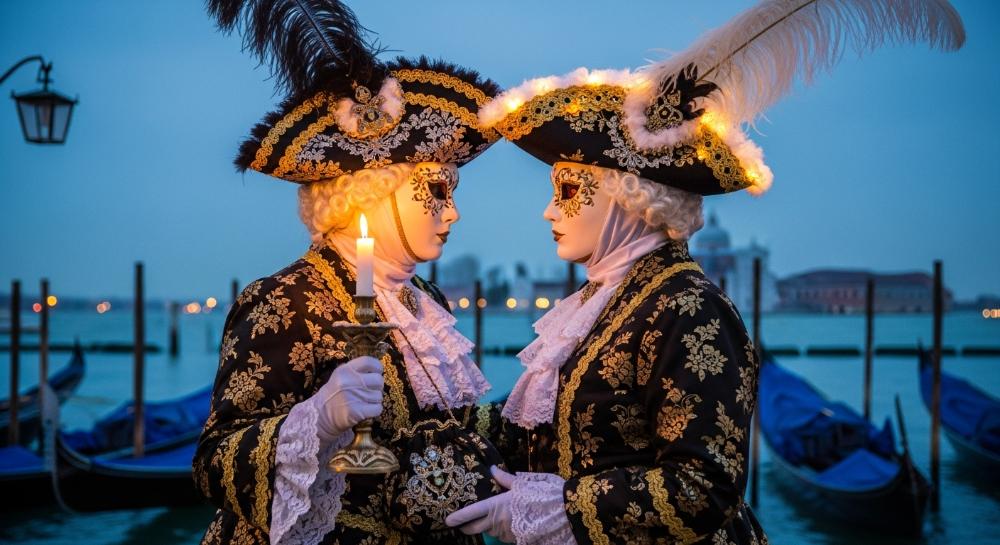
Crowds are massive, so either arrive early to popular spots or just embrace the controlled chaos. Reservations for major events open in June, so check the official Carnevale di Venezia website when the full program drops for details on which events you want to secure tickets for.
15. Lyon, France: Lumière Festival
Lyon’s Festival of Lights (Fête de la Lumière) transforms the city into an illuminated wonderland. Monumental buildings become screens for light art; streets glow with installations. It’s Europe’s most impressive light festival.
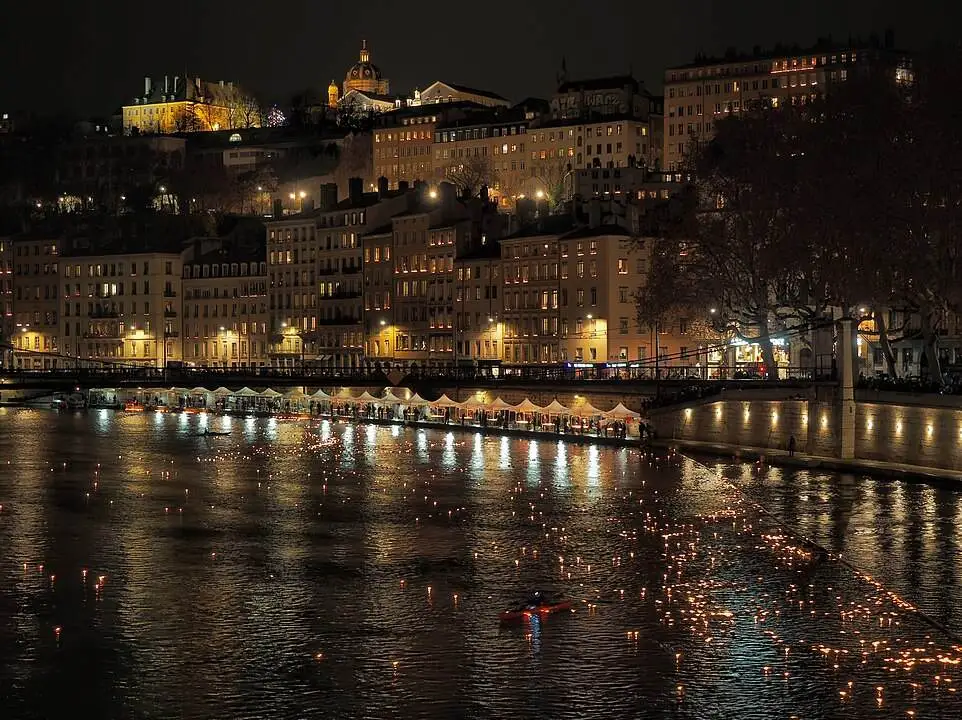
The festival traditionally runs early December. For 2025, the dates are from 5 to 8 of December. 4 nights of city-wide light projections turn Lyon into an open-air art gallery. Attendance exceeds 4 million visitors.
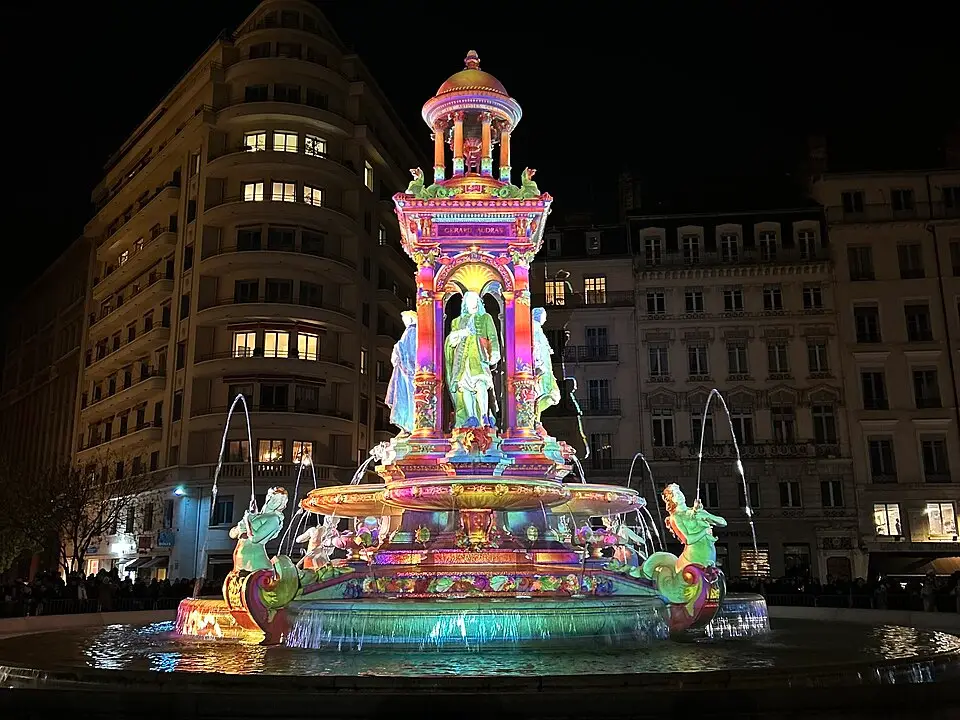
Monuments like the Basilica of Notre-Dame de Fourvière become backdrops for projection art. Contemporary light artists create site-specific installations throughout the city. Street corners feature interactive displays where visitors trigger light responses.
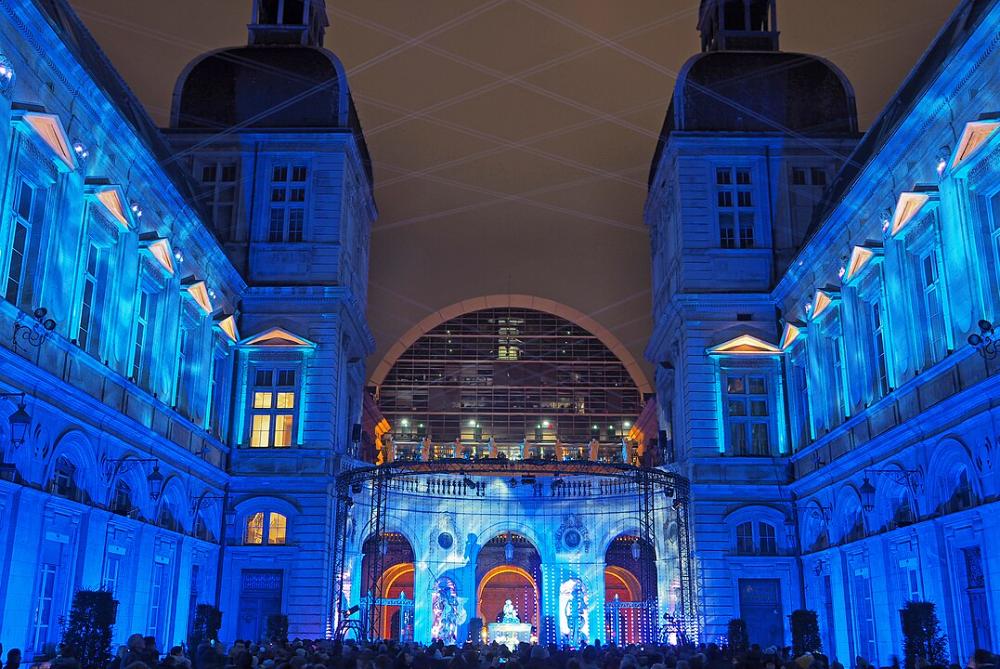
Historic Vieux Lyon (Old Town) is the festival’s heart, with Renaissance buildings framing light art. Traboules (internal passageways between buildings) become tunnels of light. Modern installations contrast with medieval architecture.
Tip
Lyon has excellent museums (Confluence Museum, Fine Arts Museum) for daytime exploration. Festival is free; just arrive early for good viewing spots
16. Netherlands: Dutch Ice Sculptures
The Dutch Ice Sculpture Festival (Ijsbeelden Festival) in Biddinghuizen features 45 world-class ice artists creating 100 monumental sculptures. It’s Europe’s premier ice sculpture exhibition combining artistry with winter spectacle.
Biddinghuizen is a small town in northern Netherlands near the Markermeer lake. The 2025-2026 festival runs December 13, 2025 – March 8, 2026, every Tuesday to Sunday from 10:00 AM to 5:00 PM. The adults tickets are around 20 EUR.
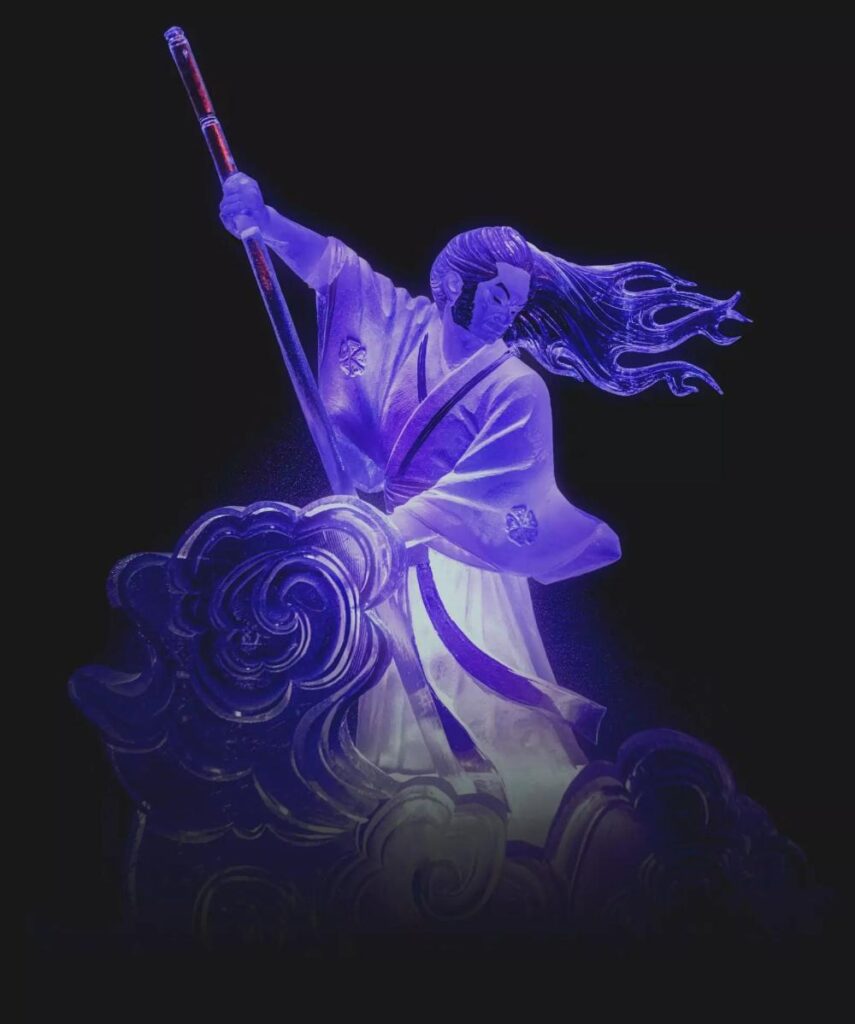
Artists from 16 countries compete, creating 100 sculptures from 550 tons of ice. The level of detail and creativity is astounding: lifelike animals, abstract forms, narrative scenes, all carved from blocks of ice.
The 2025-2026 theme is ‘An Undiscovered World.’ Artists are encouraged to explore hidden beauty, unexplored landscapes, and mythical creatures. Live carving happens during festival hours—you watch sculptures emerge.
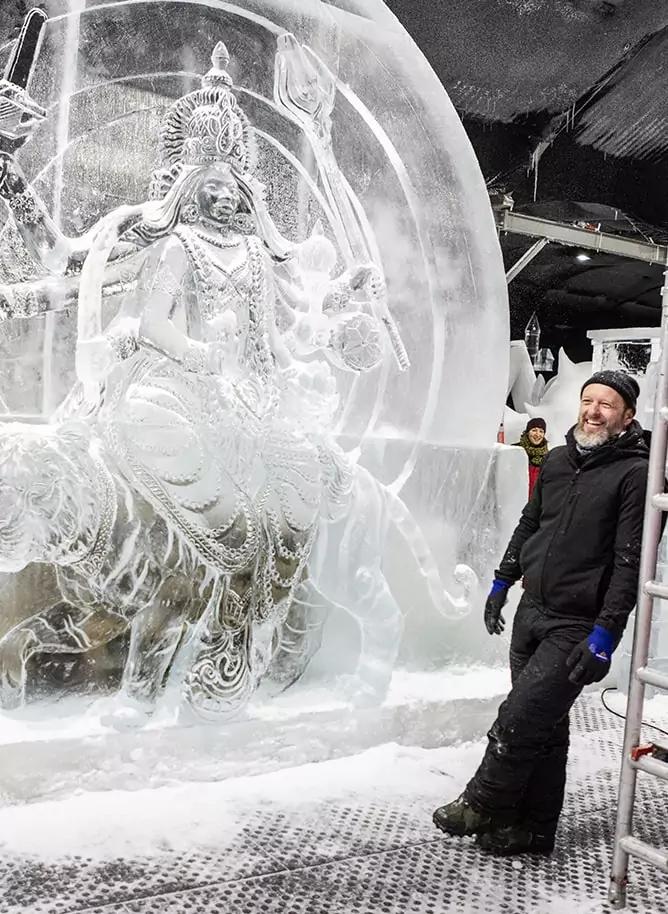
Visitors can try ice carving during workshops. Kids’ areas feature ice sculpture activities. Evening illuminations turn sculptures into glowing art. It’s a fully immersive ice art experience.
Best Time to Visit Ijsbeelden Festival
- Visit early February for spring weather and well-developed sculptures
- Attend in evening for illuminated sculptures; they’re magical under lights
- Festival is outdoors; dress warmly and bring waterproof shoes
- Stay in Amsterdam and take a train/car to Biddinghuizen (2 hours)
17. Central Lake District, England: Winter Wonderland
The English Lake District becomes a storybook setting in winter. Frozen lakes, snow-covered peaks, holiday markets, and cozy lakeside villages create an intimate winter escape, set apart from the crowds of Alpine resorts.
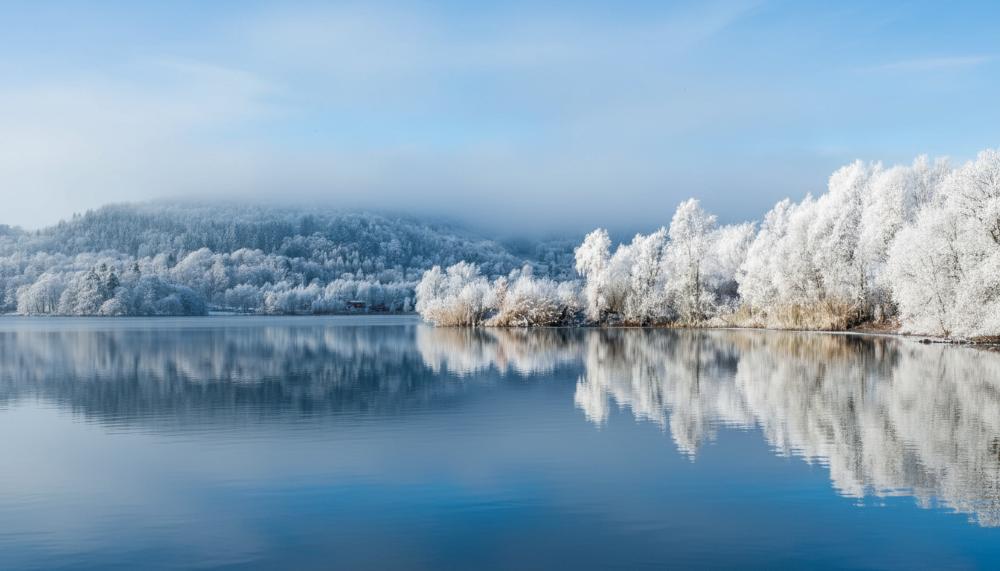
Windermere is England’s largest lake. In hard winters, it partially freezes, allowing ice skating and ice fishing. Winter walks along the frozen shore are atmospheric. Boat tours operate in milder winters, offering lake views and wildlife spotting.
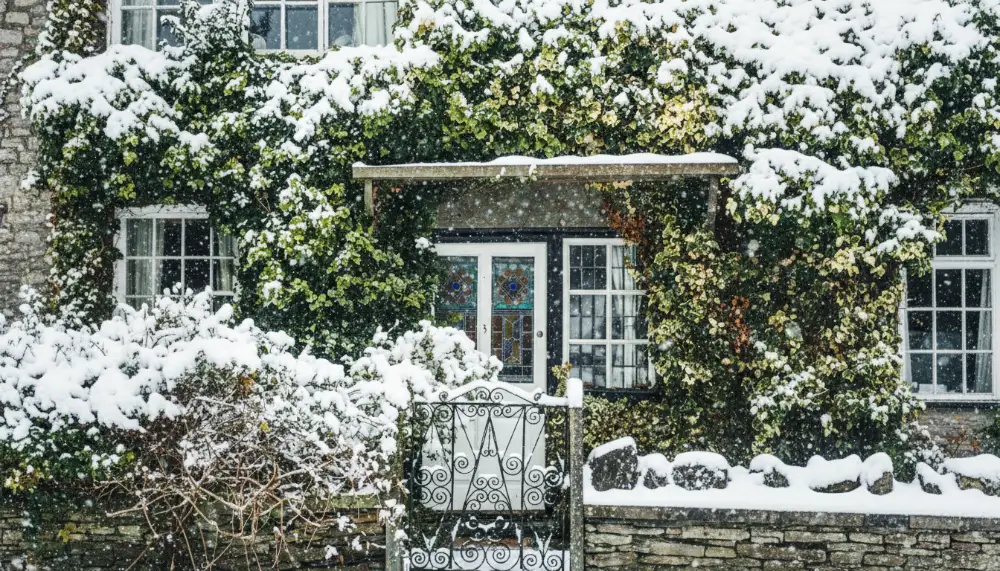
Ambleside and Bowness host festive Christmas markets in December and January. Stalls sell handmade crafts, mulled wine, roasted chestnuts, and local food. The markets feel authentically British, not commercialized like continental European markets.
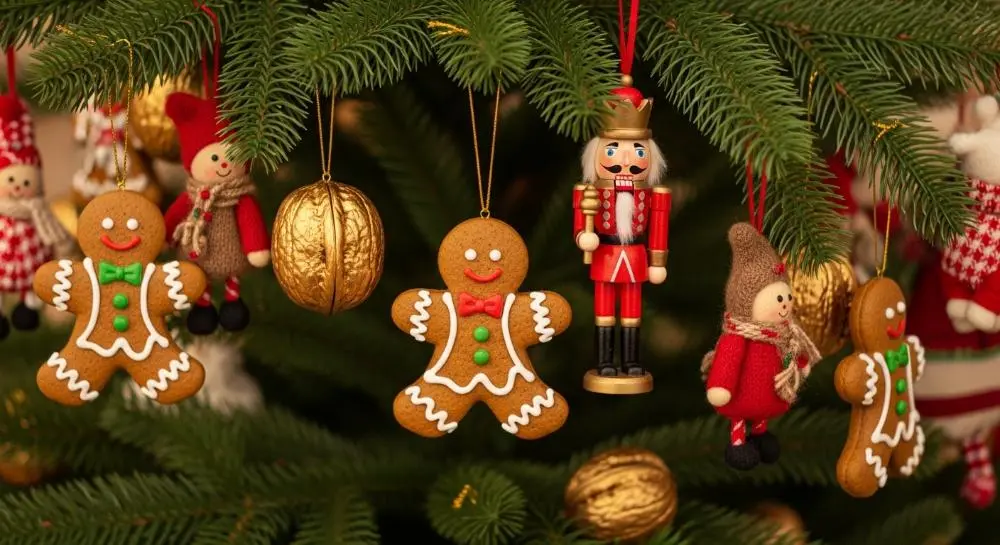
Lake District accommodation ranges from stone cottages with fireplaces to luxury lodges with lake views. Winter hiking through fells (hills) rewards effort with panoramic views. Famous walks include Catbells, Helvellyn, and Scafell Pike.
Tips for visiting Lake District in winter
- Winter activities: Lake walks, fell hiking, indoor rock climbing at climbing gyms
- Limited skiing: Lake District doesn’t have major ski resorts
- Cozy pubs serve hot chocolate, British ales, and hearty stews
- Base in Ambleside or Windermere town; both have hotels and services
2025-2026 Winter Events in Europe
Peak season hits during the New Year holidays (December 20 through January 2) and pretty much all of February weekends, so expect crowds and higher prices. But if you’re flexible, January 5-31 or early-to-mid February is actually where it’s at for deals.
| Destination | Dates | Main Event | Best For | Booking Window |
|---|---|---|---|---|
| Tyrol, Austria | Dec-Mar | Skiing + Snowbombing (Feb) | Skiers, Party | 3 months |
| Grindelwald, CH | Dec-Apr | Family skiing + Toboggan | Families | 2 months |
| Valais, CH | Dec-Apr | Luxury skiing + Spas | Couples, Luxury | 3-4 months |
| Bernese Oberland | Dec-Apr | Snowshoeing + Hiking | Hikers, Non-skiers | 2 months |
| Chamonix, France | Dec-Apr | High-altitude hiking | Experienced hikers | 1-2 months |
| Scottish Highlands | Dec 29-Jan 1 & Jan 27 | Hogmanay + Up Helly Aa | Festivals | 4 months |
| Dolomites, Italy | Dec-Mar | Skiing + Rifugios | Skiers, Foodies | 2-3 months |
| Finnish Lapland | Dec-Feb | Aurora + Glass Igloos | Aurora chasers | 6-12 months |
| Swedish Lapland | Dec-Apr | ICEHOTEL + Aurora | Bucket-list travelers | 6-8 months |
| Northern Norway | Dec 20-Apr 1 | Sorrisniva + Aurora | Remote Arctic | 3-4 months |
| Lake Bled, Slovenia | Dec-Feb | Hiking + Markets | Budget travelers | 1-2 months |
| Transylvania, Romania | Dec-Feb | Wildlife tracking | Adventure seekers | 1 month |
| Bavaria, Germany | Dec-Mar | Skiing + Mittenwald | Budget + Culture | 2 months |
| Venice, Italy | Mid-Feb to Mar | Carnival | Culture + History | 3-4 months |
| Lyon, France | Dec 8-11 | Light Festival | Art + Photography | 2-3 months |
| Netherlands | Jan-Mar | Ice Sculpture Fest | Art lovers | 1-2 months |
| Lake District, England | Dec-Feb | Holiday markets | Families, cozy | 1-2 months |
You’ll catch that sweet spot after the holiday madness dies down, but before school breaks start. One pro tip: grab your ski passes online before you go, you’re looking at like 15-25% off if you book ahead.
What to Expect in Europe during winter
- Alpine regions (-5 to -15°C): Manageable with proper clothing
- Arctic Lapland (-20 to -30°C): Extreme; limit outdoor time and warm up frequently
- Darkness: December-January = 6-8 hours daylight in Alps, continuous darkness in Arctic
- Aurora visibility: Not guaranteed; even perfect conditions offer only 50-70% sightings
Why Winter in Europe is Worth the Cold
Europe in winter is magical. Mountains wear white cloaks. Cities glow with holiday lights. Ancient traditions come alive through fire festivals and carnivals. Northern lights dance overhead. Glass igloos offer views of cosmic shows.
The crowds thin, prices drop slightly, and the rush dissipates. Winter demands preparation and investment, but the payoff is transformative. You’ll return home with stories of aurora borealis, Venetian masks, ice sculptures, and Alpine silence that summer visitors never experience.

